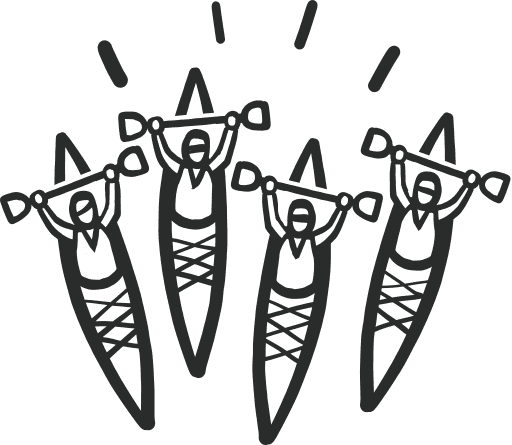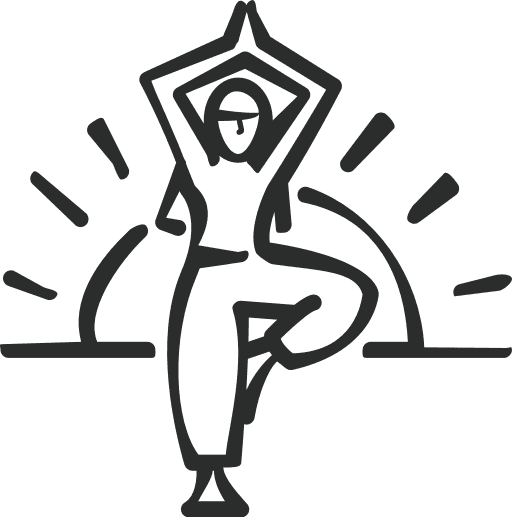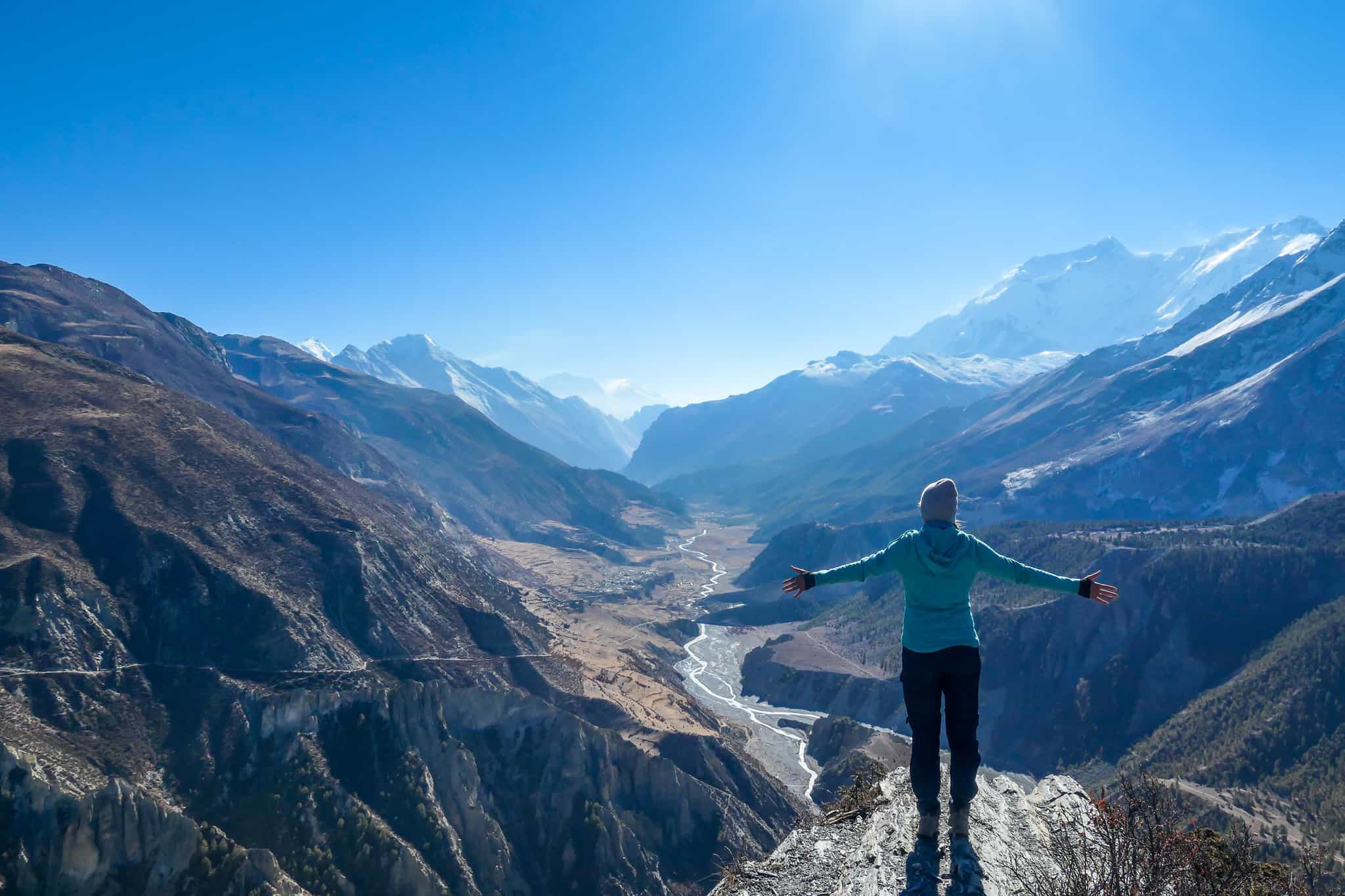
Trek the Annapurna Circuit
High-altitude trails, epic scenery and the highest navigable pass on the planet – this is bucket list stuff in the making
What's Included?
Activities & Certified Guides
Expert, local, English-speaking guidesAll accommodation
4 nights in hotels or guesthouses; 12 nights in teahousesMeals
3 breakfasts and 2 dinnersInternal flights & transfers
Flights between Jomson and Pokhara; airport transfers and all local transfersPermits & Porterage
Porters to transport your overnight luggage; all entry fees and permitsSmall Like-minded Groups
Solo-friendly by design, join our small n’ sociable groups of up to 12 like-minded, active and outdoorsy people…
…
What's it like?






























Explore one of the most incredible trekking routes in the Himalayas – 145km of devastatingly beautiful mountains
Cross through the thrilling Thorong La Pass (5416m), the highest point of the Annapurna Circuit Trek
Enter Kali Gandaki, the deepest gorge in the world – a whopping three times deeper than the Grand Canyon
Key Information
Day 1
Kathmandu awaits
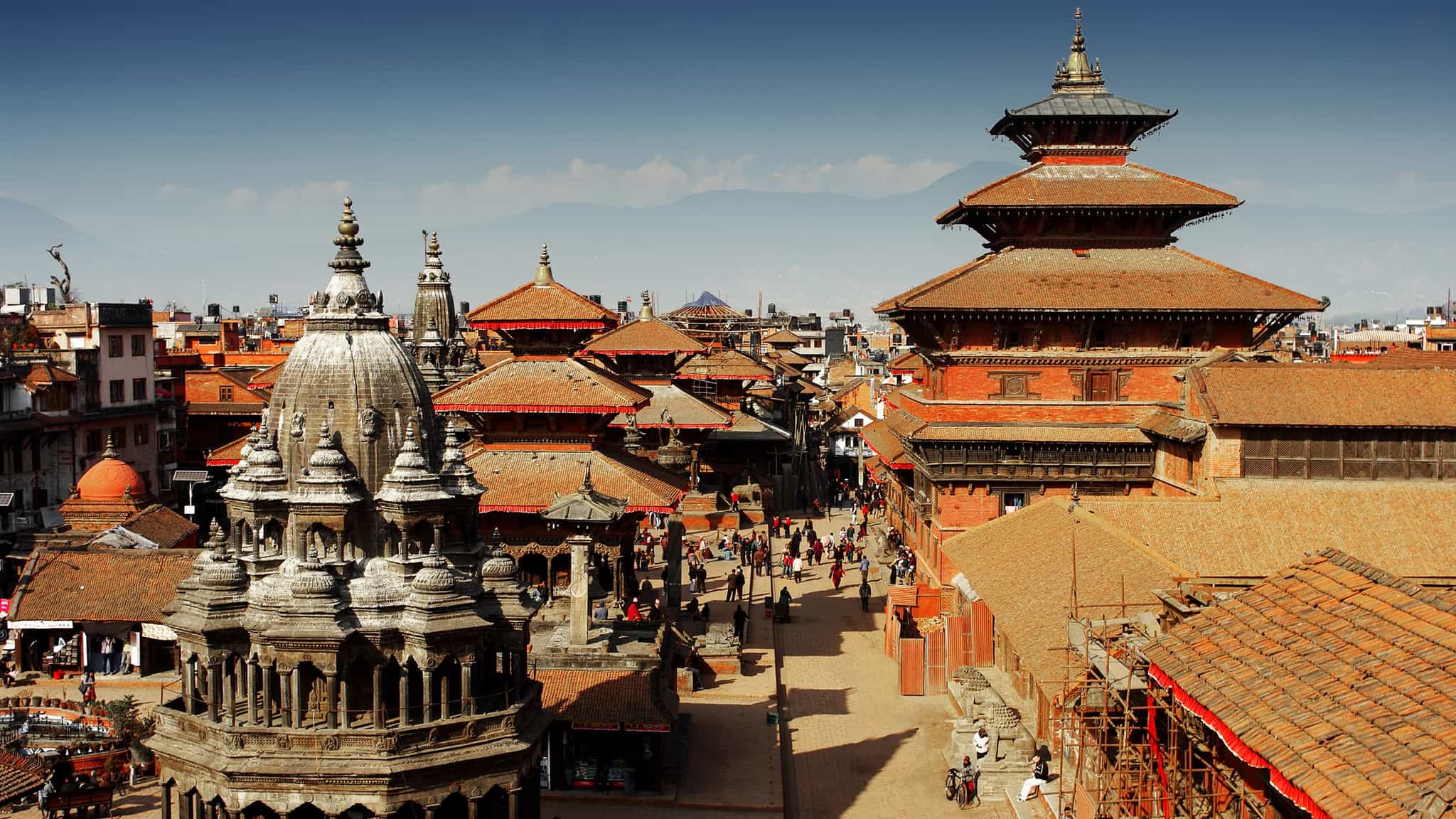
Check into your guesthouse in Thamel – heart of the sensory overload that is Kathmandu. Join a pre-departure meeting with your guides to run through the plans for the Annapurna Circuit Trek and then finish the day with a group dinner alongside the rest of your team.
Day 2
The road to Tal
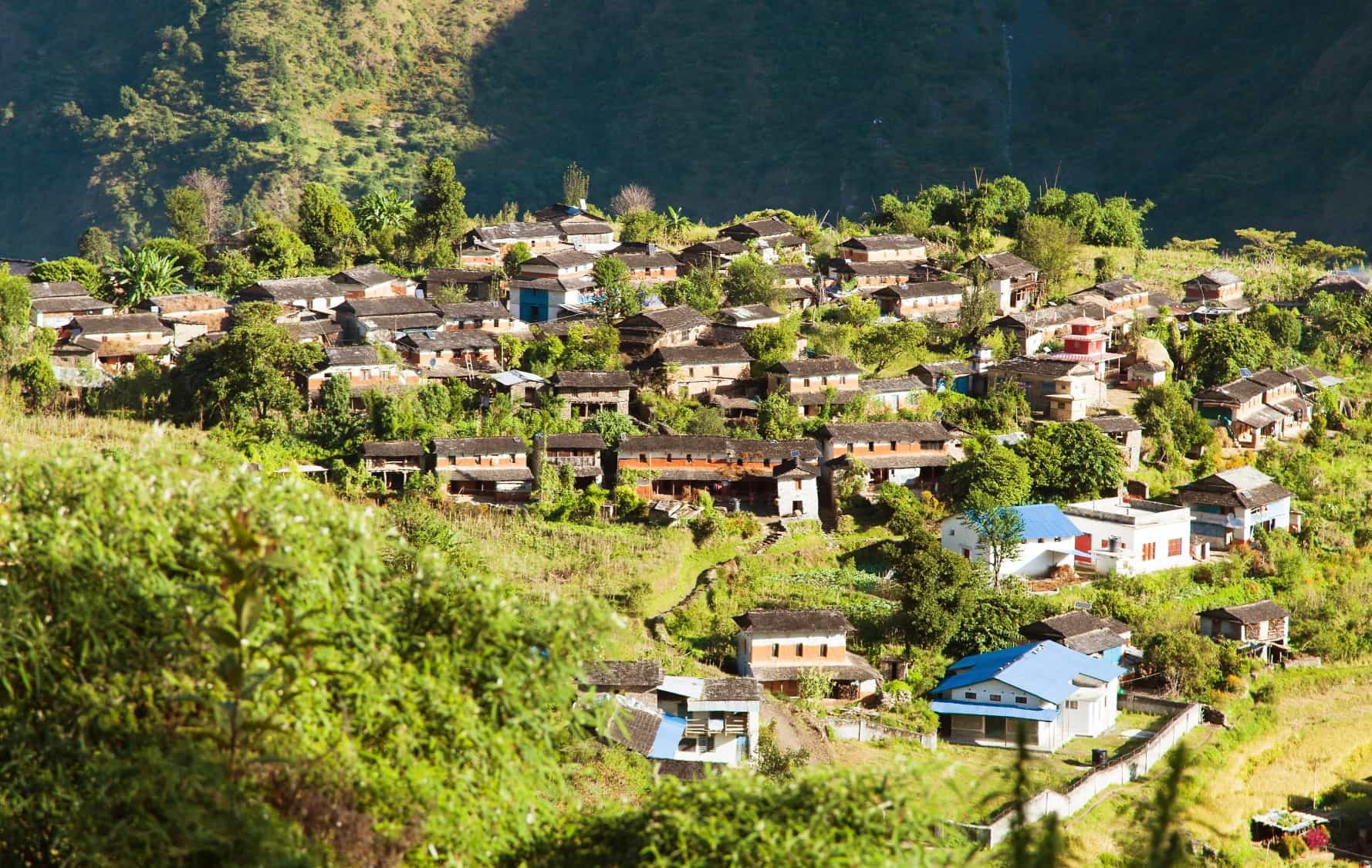
Driving
This morning you'll start the long journey to Besisahar, driving through lush river valleys, stunning Himalayan scenery and terraced farmland. Stop for lunch, then swap to a local jeep and continue on to the remote village of Tal, the starting point of your trek. Cross beautiful, rugged terrain with steep ravines, streams, waterfalls and a bunch of tea houses, then check into a local guesthouse and rest ahead of the epic adventure starting tomorrow.
Day 3
First steps on the circuit
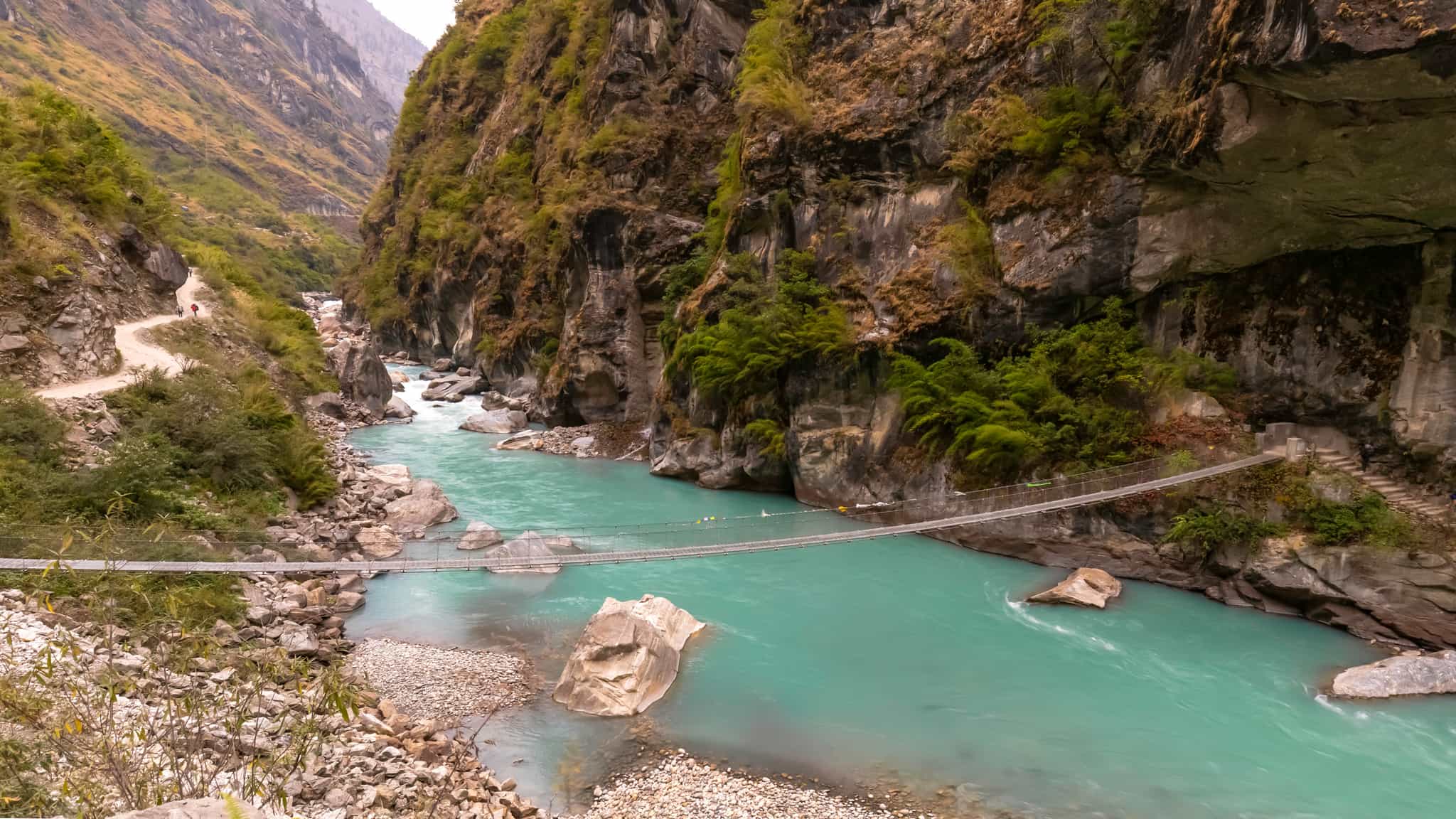
Hiking
Follow a rough track out of town and along the Marshyangdi River. Walk through the narrow valley, following the jeep track which passes through the village of Dharapani, where your permits will be checked. Continue hiking through the forest, gaining altitude gradually, then cross into the insanely beautiful Bagarchap Valley and spend the night in your first traditional Himalayan teahouse at 2160m.
Day 4
Bagarchap to Chame
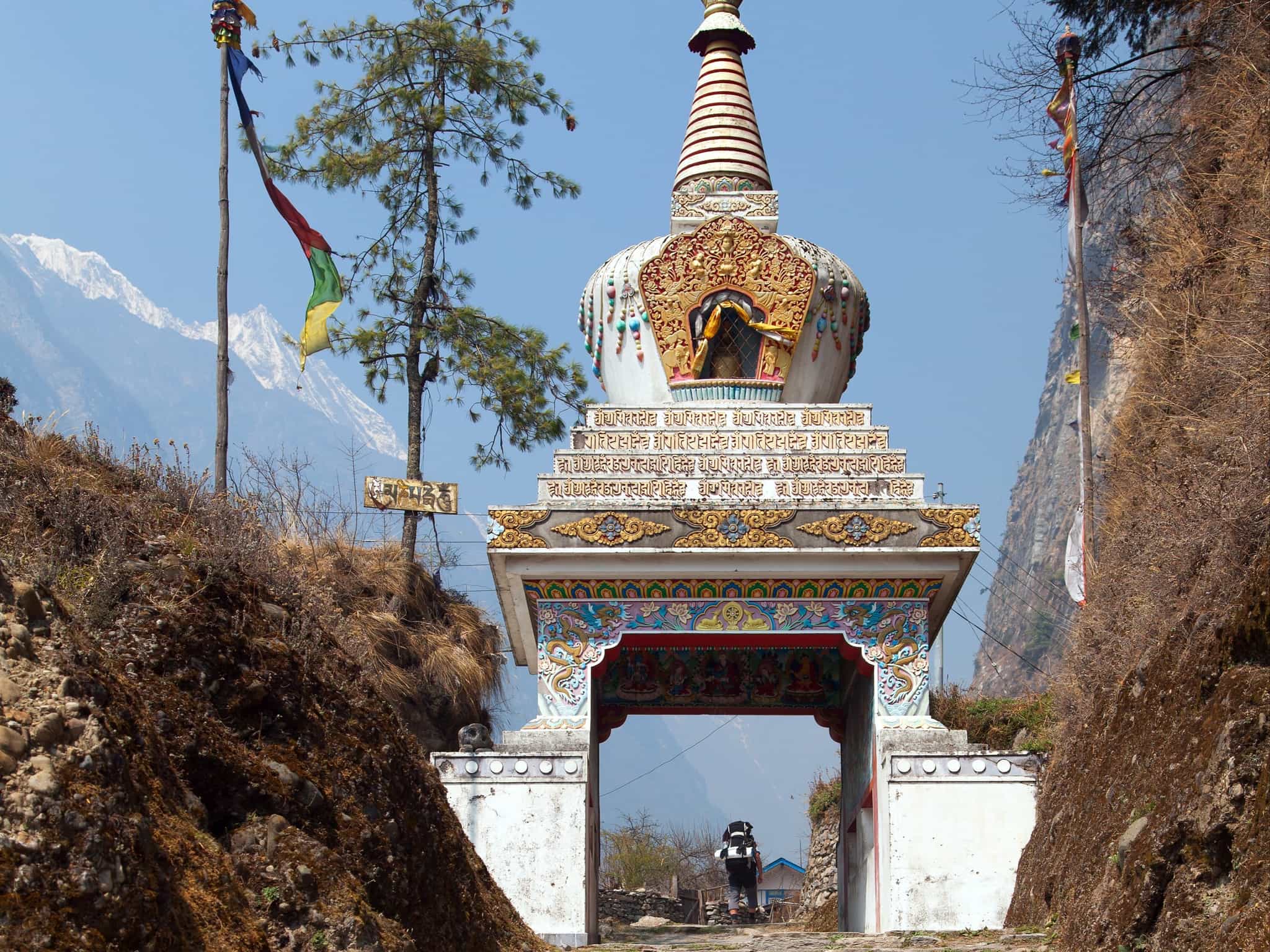
Hiking
Hike past a small waterfall and follow a steep uphill trail through a beautiful mixed forest of rhododendron and oak, gaining more than 400m elevation in a single stretch. On reaching Timang village, enjoy a well-deserved lunch and sip hot tea or coffee, while admiring the mesmerising views of Manaslu Peak from a panoramic terrace. Hit the trail again and ascend gently, passing the beautiful villages of Thanchok and Koto and finally reach Chame (2670m), your base for tonight.
Day 5
Chame to Upper Pisang
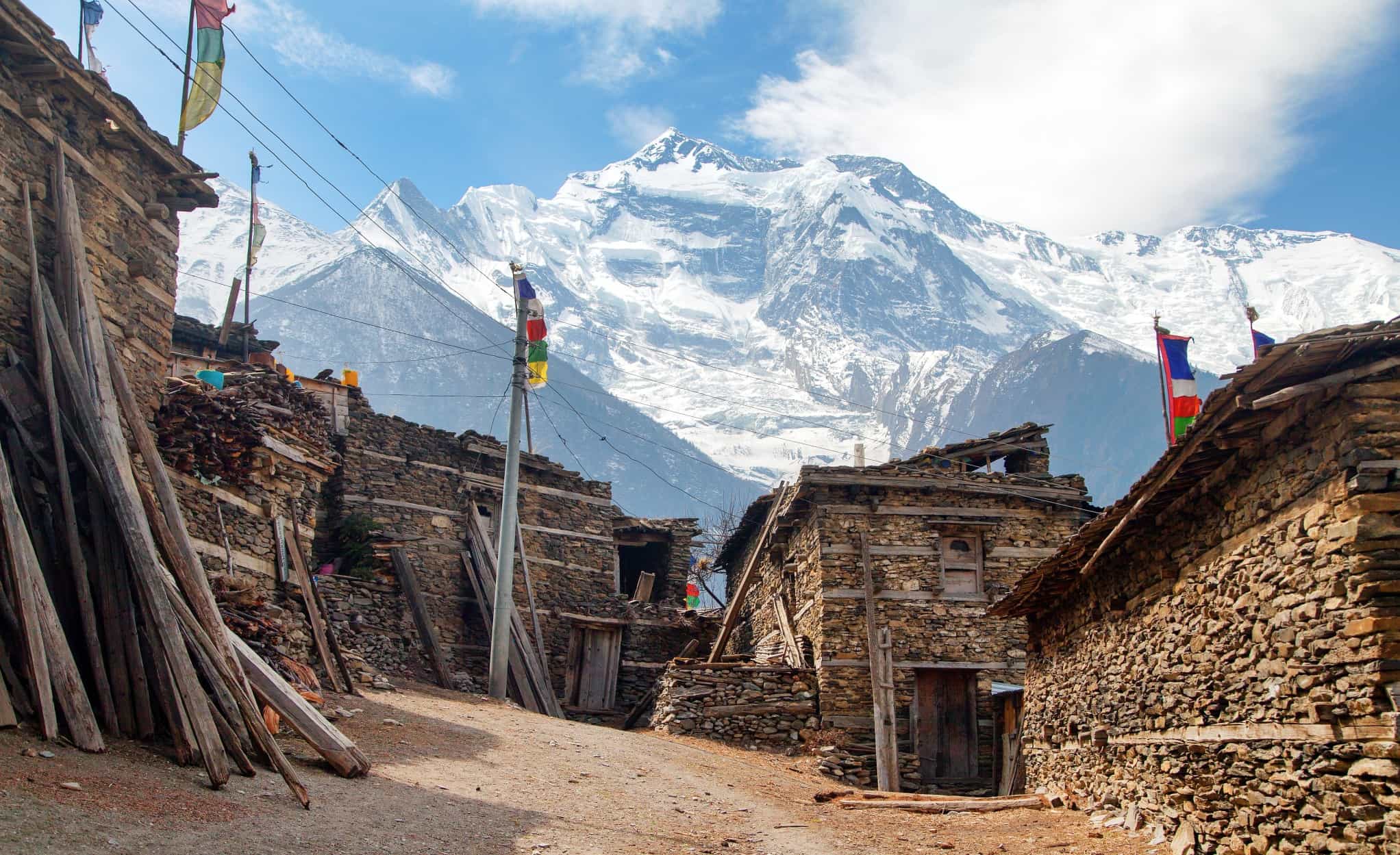
Hiking
Things get serious today, as you'll climb above 3000m. Cross the Marshyangdi River and walk past a chorten (shrine), then hike an undulating forest trail to Bhratang. A beautiful waterfall appears on the other side of the mountain as you change direction. Cross the river once again, and ascend to Dhikur Pokhari for lunch. To your right stands Swargadwari, a huge bare rock formation which is believed to be the path to Swarga (heaven). As you trek on, the valley becomes wide and vegetation sparse. End the day in the small village of Pisang at 3300m.
Day 6
Upper Pisang to Manang

Hiking
Set off hiking through a lush zone of yak pastures and crop fields, stopping for photos at a remote Tibetan monastery. Ascend on a winding path to the remote village of Ghyaru. From here onwards, the trail rolls through arid landscapes all the way to Ngawal. Stop for lunch, then continue on to Manang (3540m), one of the largest villages on the circuit. Be sure to listen out for the local Manangi language, unwritten and dangerously close to extinction.
Day 7
Acclimatisation day
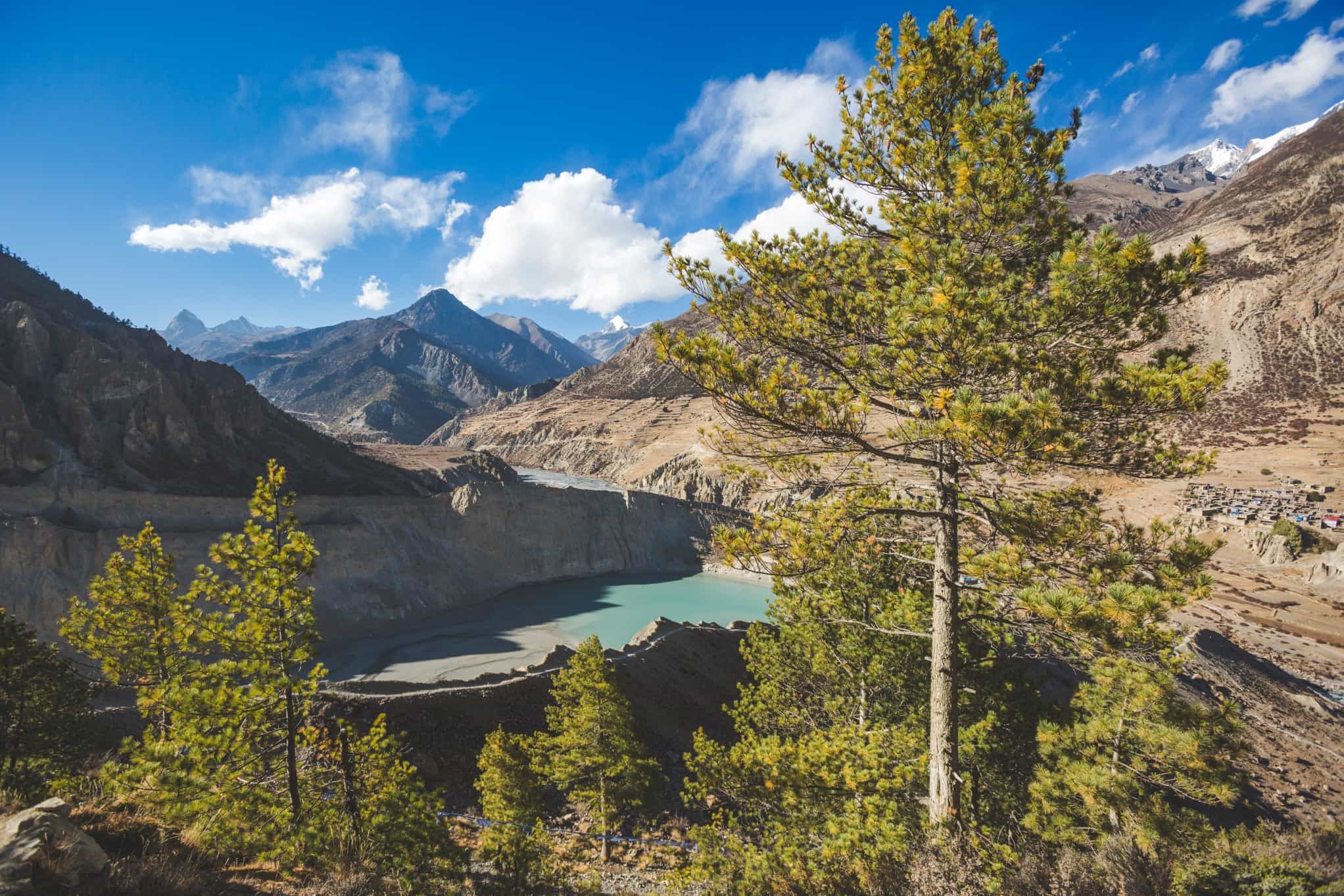
Spend the day acclimatising to the altitude. Enjoy a cup of smoky chai in Manangi town and take a leisurely walk through the old alleys, exploring the traditional stone-thatched houses with intricate wooden windows and prayer flags flapping in the air. If you are feeling energetic, take an optional walk to Gangapurna Lake, or visit the Himalayan Rescue Association post to see how they're saving lives across some of the most challenging terrain in the world.
Day 8
Manang to Sri Kharka
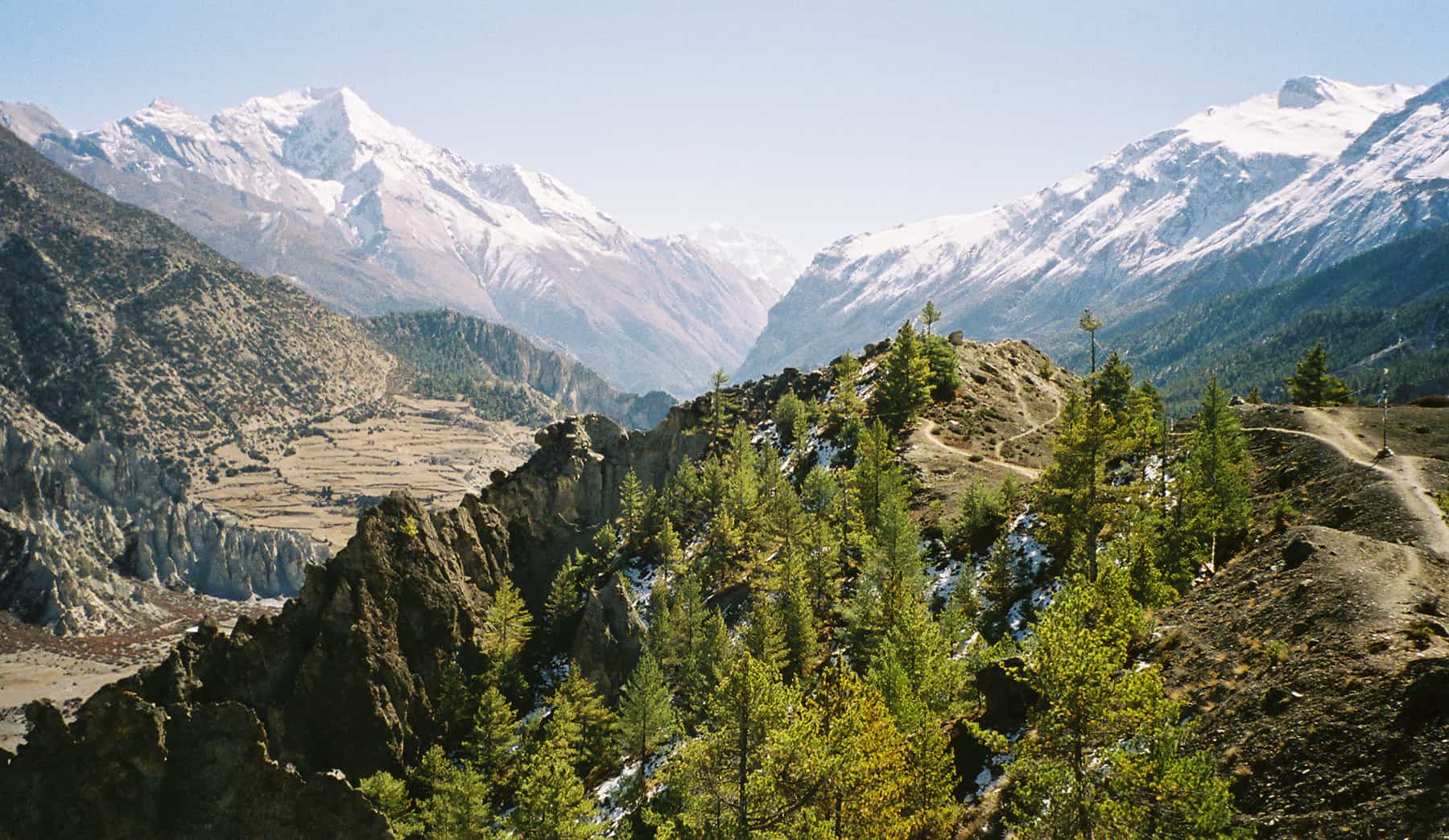
Hiking
Today you'll hike along a rarely used and completely idyllic stretch of trail as you climb to Sri Kharka. Start off hiking through barley and buckwheat fields and across Thorang Khola River via a suspension bridge. Continue with a gentle ascent on a wide trail through juniper forest and meadows to Khangsar, the last village in the area. You will notice the effect of the low oxygen level in your body while climbing, but a slow gradual ascent will make the going manageable. Reach Sri Kharka (3880m), tuck into a well-deserved hot meal and enjoy the serenity of the mountains as you prepare to see one of the great wonders of the world tomorrow.
Day 9
Tilicho Base Camp
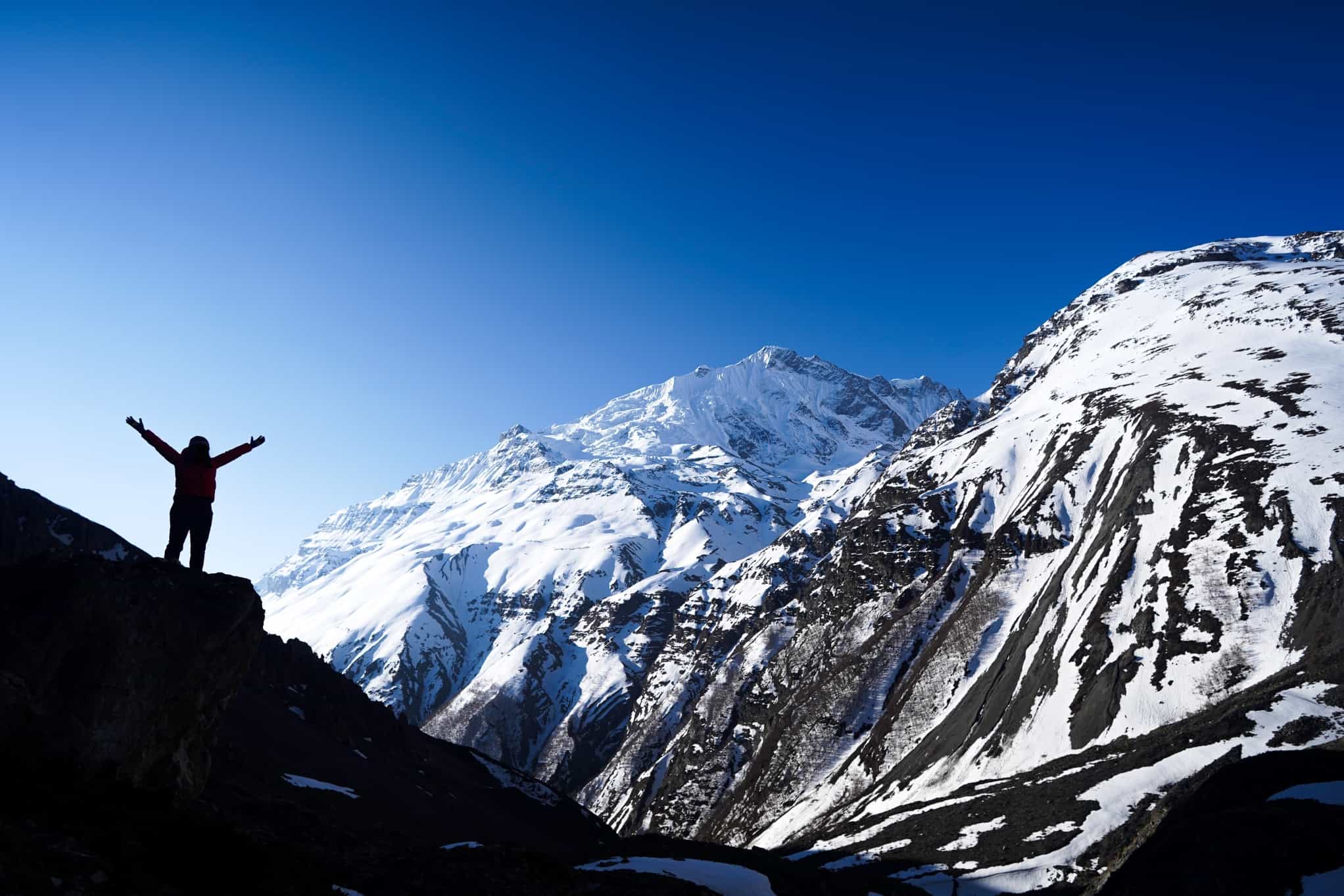
Hiking
Follow trail alongside the stunning views of Annapurna II and Gangapurna, crossing a couple of streams en route using high suspension bridges that will pump up the adrenaline. Tackle an exposed rocky slope to reach Tilicho Base Camp at 4150m. Rest up for the afternoon, then enjoy a high-altitude night sky chock full of stars. Please note, it's possible that the trail to base camp may be closed or disrupted during winter (January to March), and sometimes even in the peak season. Your guide will decide whether to continue or skip this section, based on the local weather conditions.
Day 10
Tilicho Lake
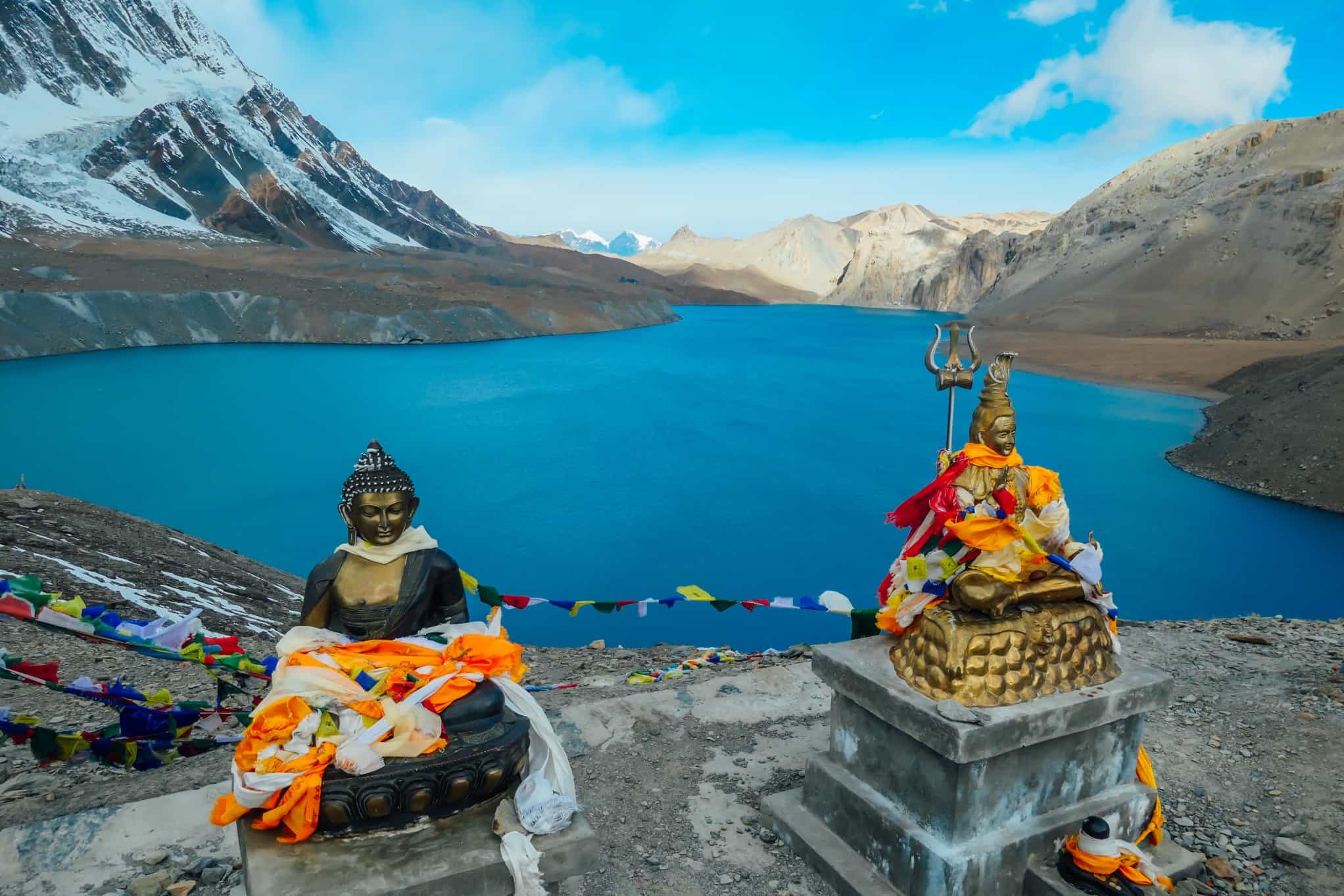
Hiking
Wake up early today and get your head torch on, to start hiking along a trail that gently climbs up the hillside. Tackle a steep ascent to reach the pass, from where the trail levels up all the way Tilicho Lake (4919m). Take time to explore one of the highest and most beautiful lakes in the world. Hike back to Base Camp for breakfast, and when you're ready, hike back down to Siri Kharka (3880m) to relax in your teahouse – you’ve earned it.
Day 11
The trail to Yak Kharka
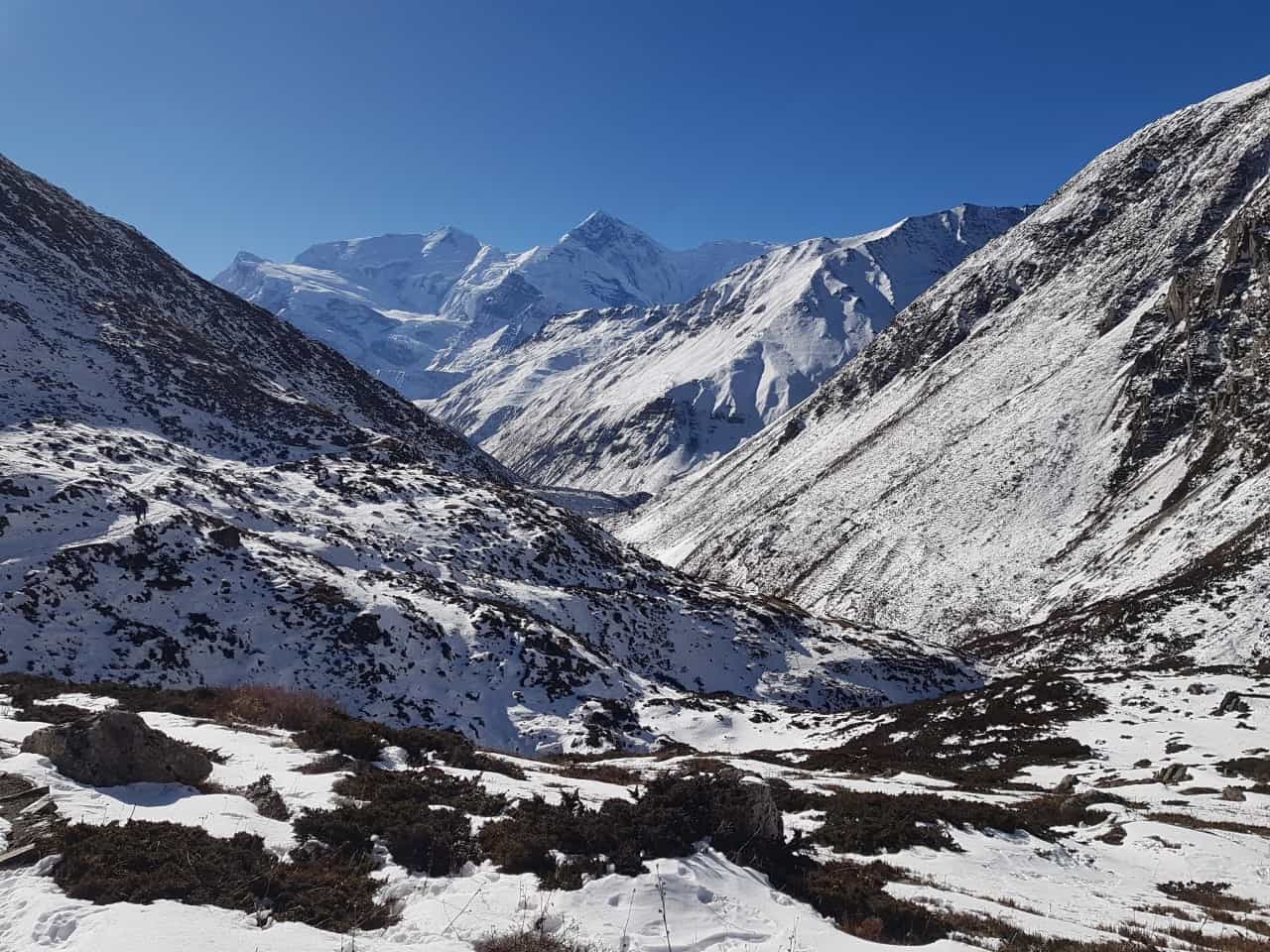
Hiking
Ascend gently to Old Khangsar, overlooking the new Khangsar village. See the ruins of the abandoned settlement with a stunning backdrop of towering peaks and the Manang Valley. Climb up gently past pastures and herds, eyes peeled for mighty yaks. As the trail reaches the ridgeline, descend to the Thorang Khola River and join the Annapurna Circuit route again, following the trail as it winds through some truly awesome scenery on the way to tonight's destination, the village of Yak Kharka (4050m).
Day 12
Prelude to the big one
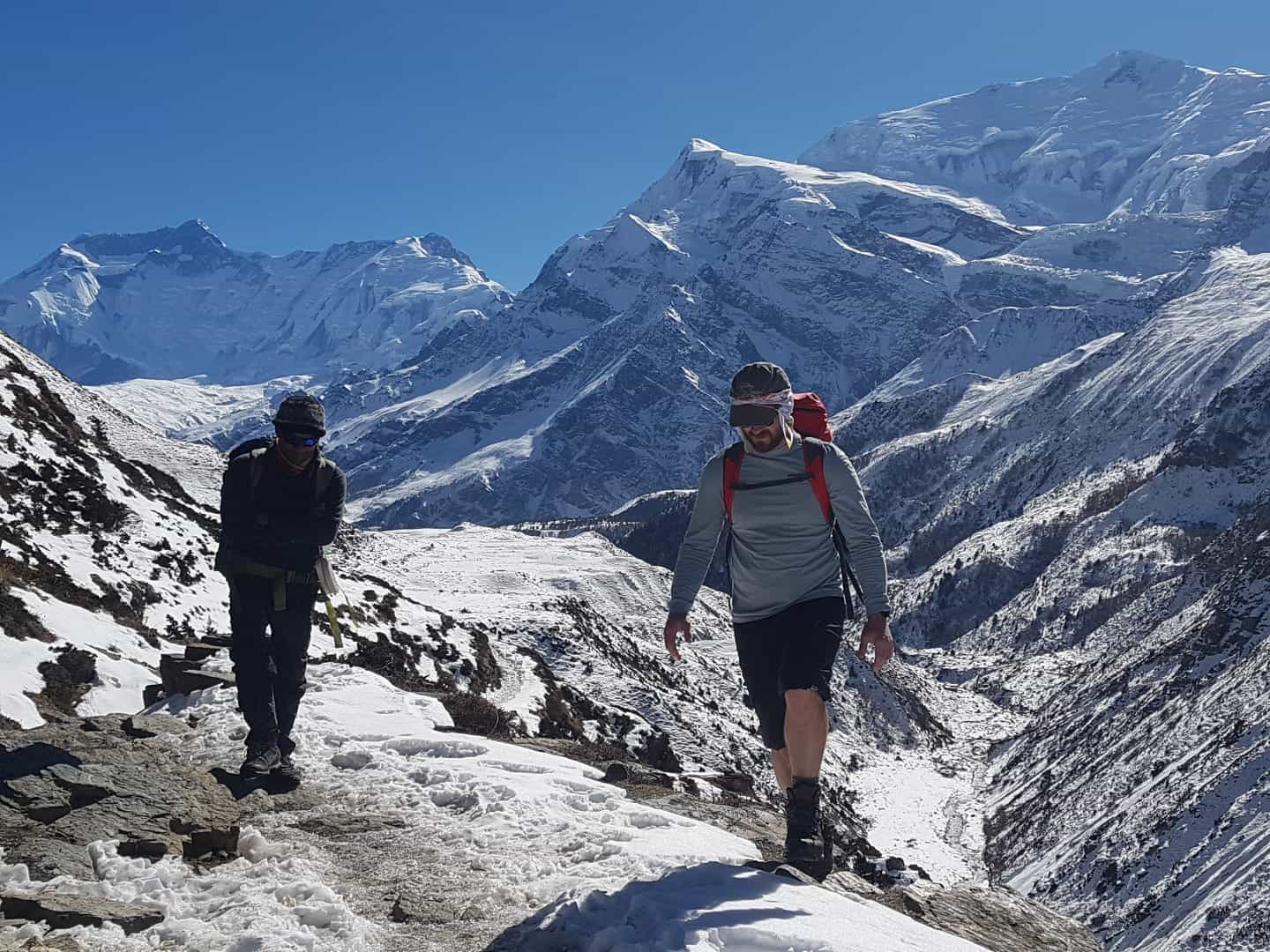
Hiking
The trail to Thorang Phedi is similar to the one you've walked a few days back – however, due to the altitude, you may notice the pace is slower and the air much thinner. Ascend gently, passing by Ledar village along a narrow and dry path, then cross the Thorang Khola River to reach Thorang Phedi Base Camp (4450m) early afternoon. Rest up for a big day tomorrow – you’ll need it.
Day 13
To Muktinath via the Thorong La pass
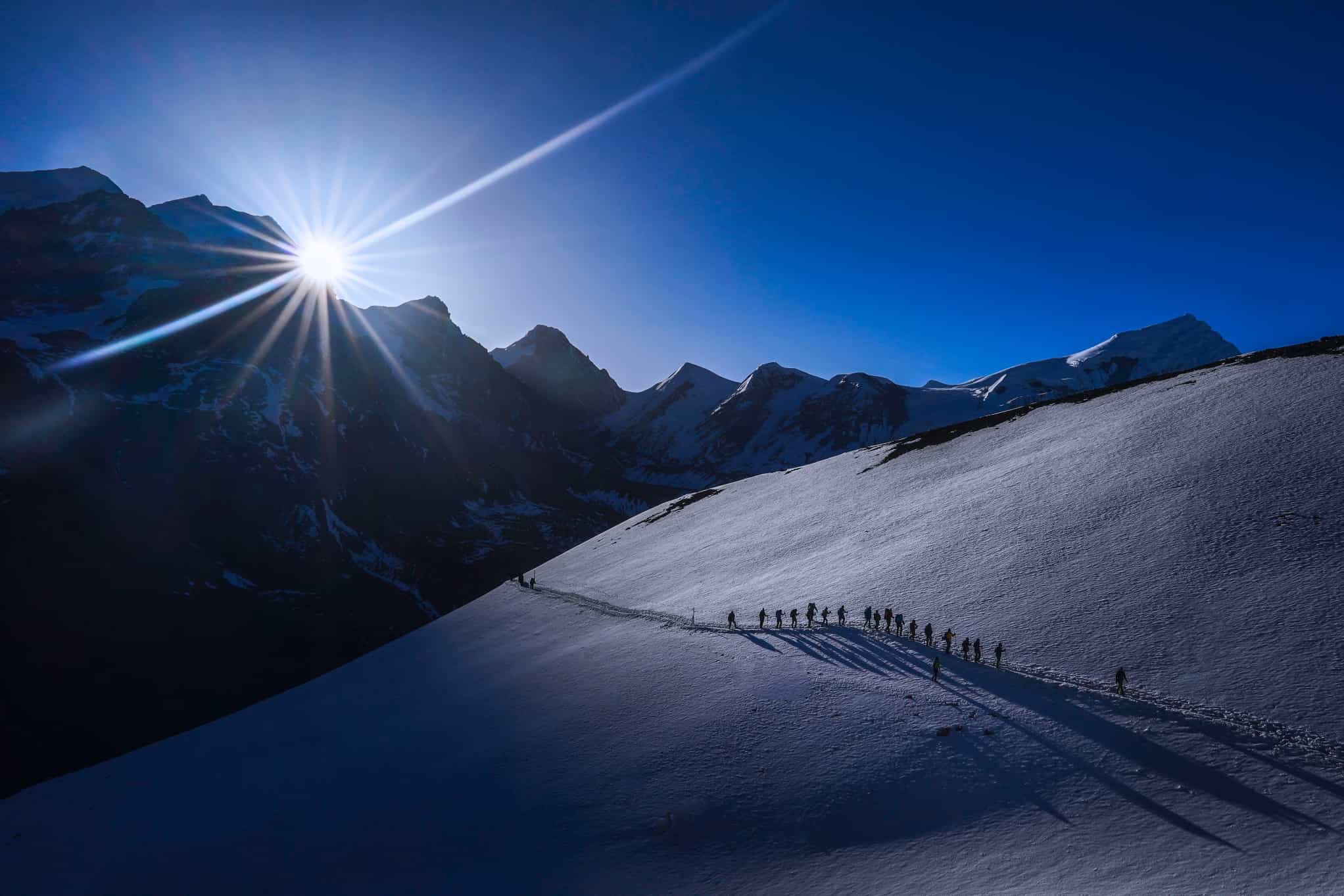
Hiking
The big one! Start the day around 04:00 am and navigate a steep uphill stretch to Thorong High Camp, the last settlement before the highest point of this trek. Cross the Thorang Khola River one final time and continue with a gradual but steady ascent all the way to Thorong La (5416m), the highest navigable pass in the world. Take a moment to celebrate your epic achievement as you soak in some of the best views of the whole circuit, including the high desert mountains along the Kaligandaki Valley – a perfect opportunity for some amazing photos. Begin your descent to Muktinath (3750m) and experience the serene Vishnu temple, holy to both Hindus and Buddhists and the perfect place to enjoy the tranquillity of the mountains.
Day 14
Descend to Jomsom
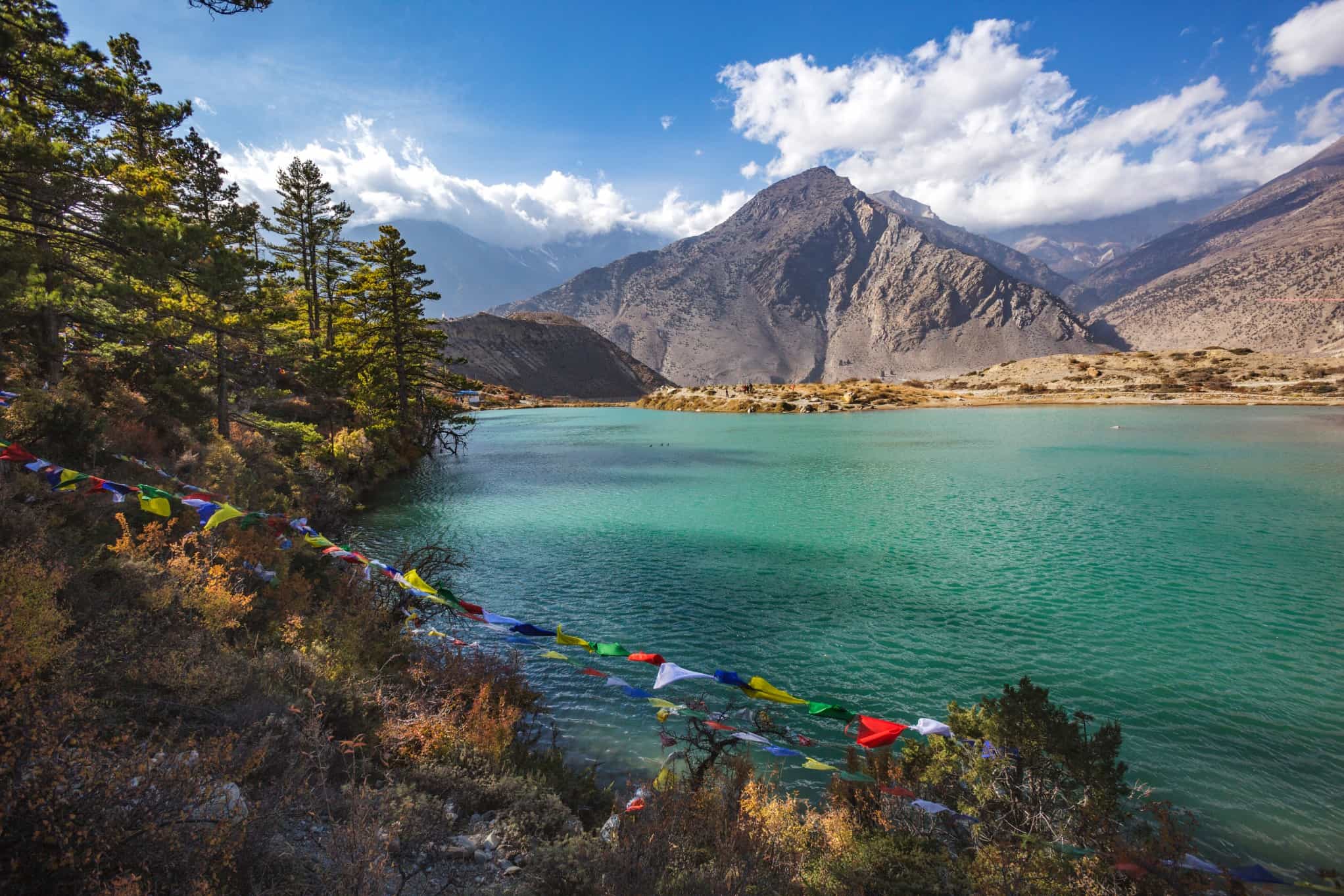
Hiking
Set off on a downhill path to Kagbeni, and follow the banks of the Kali Gandaki River as it crosses through the deepest canyon on earth. Take in the magnificent views of Mount Annapurna and Dhaulagiri and then spend the night at a teahouse in Jomsom, gateway to an ancient trade route that once spanned the Himalayas.
Day 15
Fly to Pokhara
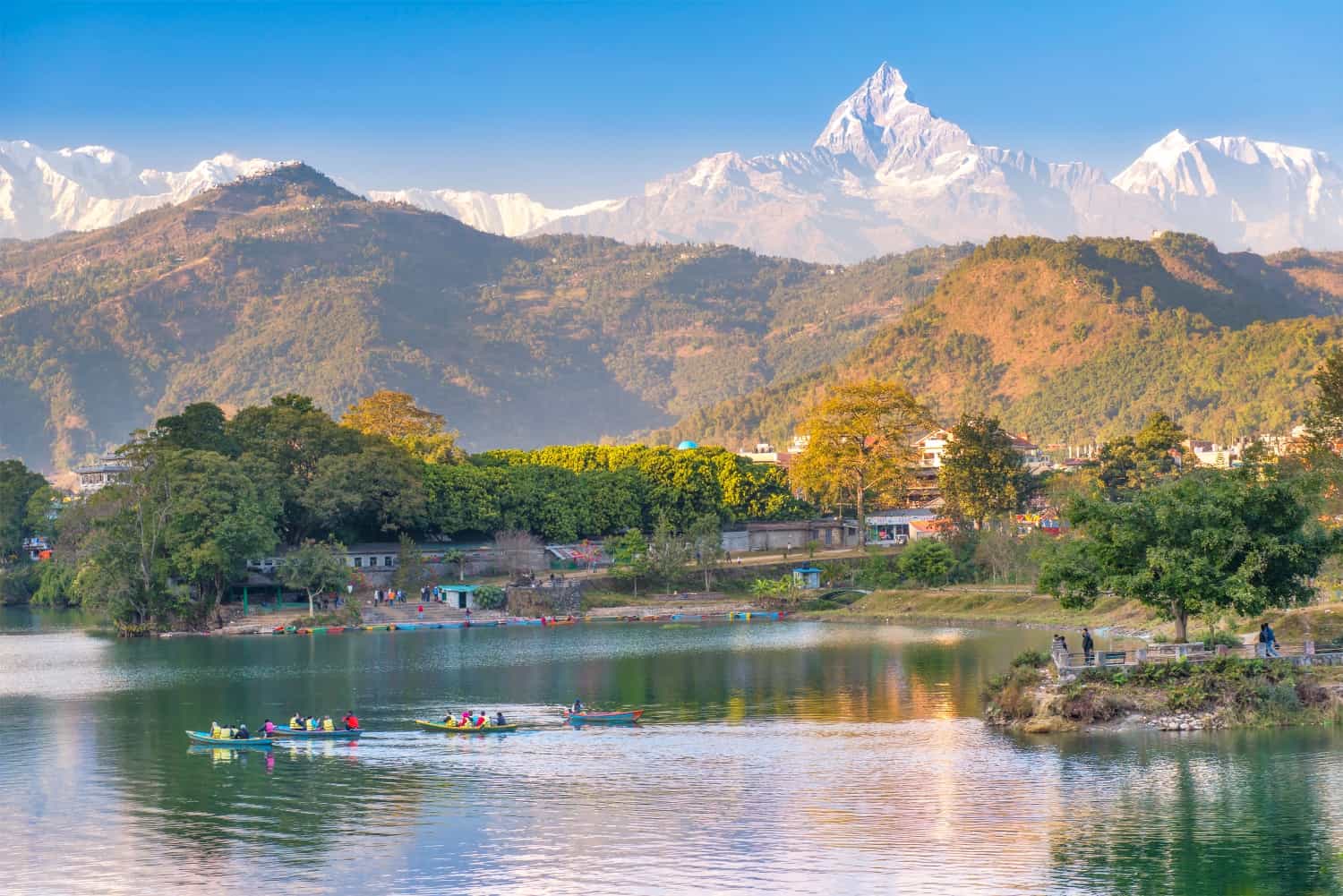
Fly over the Himalayas to the lakeside town of Pokhara and check into your hotel near the lake. (Please note, flights from Jomsom don't operate over winter – so if you're travelling between mid-November and mid-February you'll drive instead, which takes approximately 7-8 hours). Time permitting, head out to explore the picturesque lakeside promenade. Celebrate the end of the epic Annapurna Circuit trek with your group in one of the cosy waterfront bars or restaurants – you've earned it!
Day 16
Return to Kathmandu
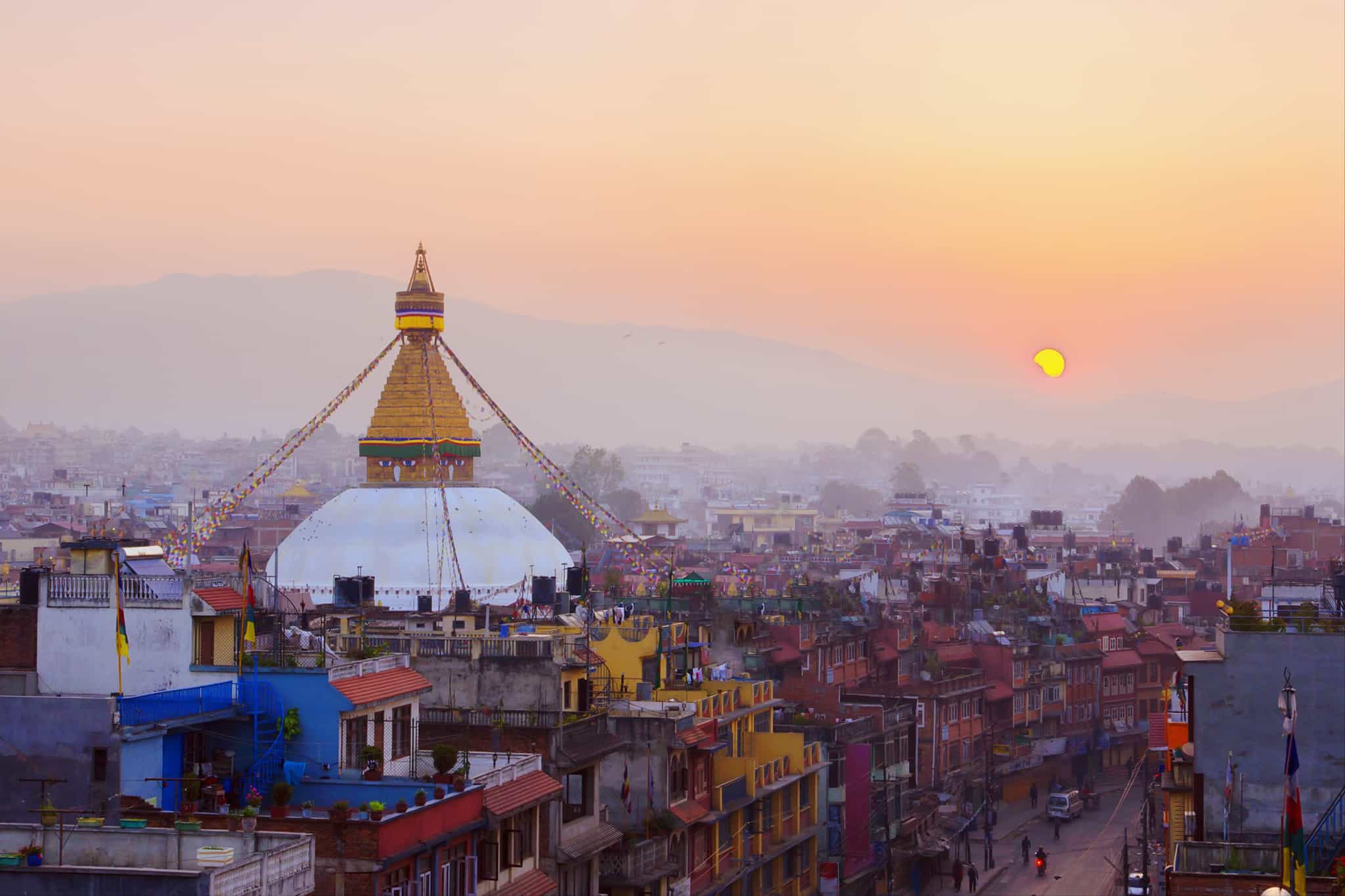
Driving
Rise early and take a bus through the mountains and back to Kathmandu (approximately 7-8 hours, depending on traffic). Spend some free time exploring the city.
Day 17
Your final day in Nepal
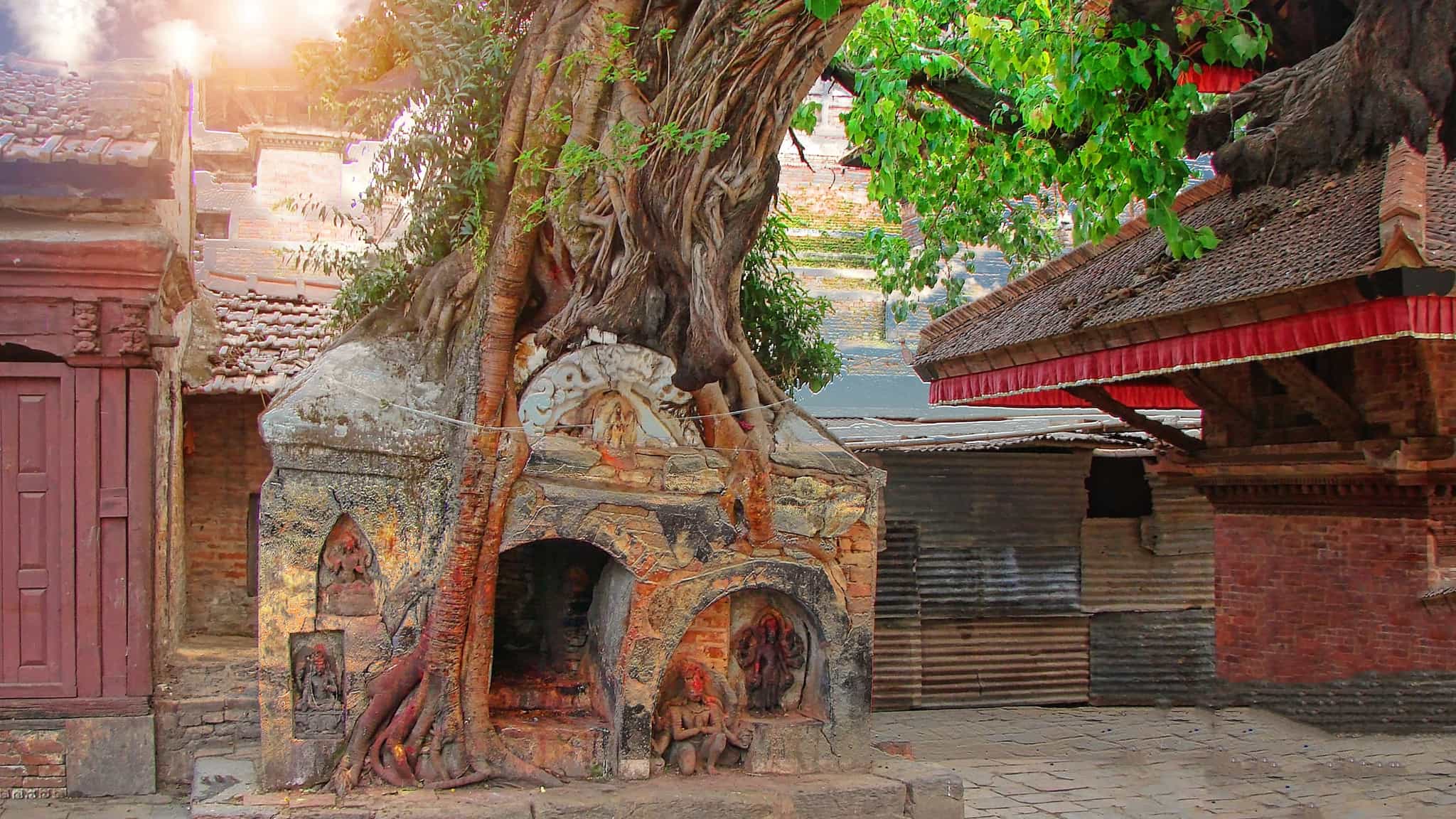
Enjoy a lie in, then explore the city some more. Visit a holy Hindu temple or one of the largest Buddhist stupas in the world, before heading for the airport and back to reality.
The Area
Logistics
Starts
Tribhuvan International Airport, Kathmandu
Arrive by 16:00 on Day 1
Ends
Tribhuvan International Airport, Kathmandu
Any time on Day 17
Transfers
Airport arrival and departure transfers are included no matter when you arrive and depart (even if you book extra nights before or after the trip), provided you have completed your passenger information form and have supplied your flight details in advance. On Day 1, your tour leader will arrange a group briefing before a welcome dinner, so we strongly encourage you to book a flight landing by 16:00 in order to be able to join this on time.
Travel options
There are regular flights to Kathmandu from major airports across the UK and Europe.
Day 1
Breakfast
Lunch
Dinner
Day 2
Breakfast
Lunch
Dinner
Day 3 – Day 14
Breakfast
Lunch
Dinner
Day 15
Breakfast
Lunch
Dinner
Day 16
Breakfast
Lunch
Dinner
Day 17
Breakfast
Lunch
Dinner
What is the food like?
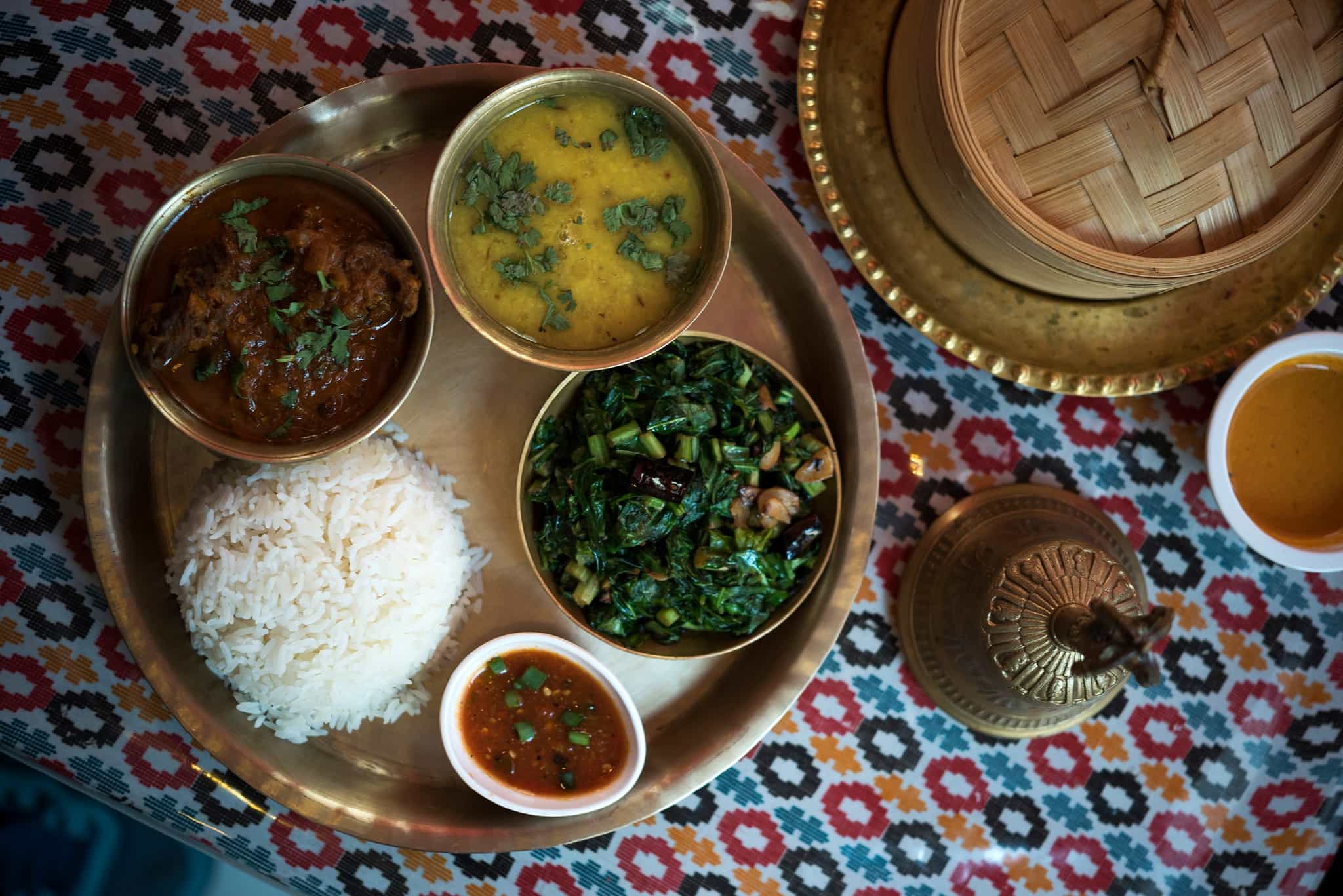
Breakfast is usually either hot porridge, muesli or Tibetan bread served with an omelette or boiled eggs. The menus in the teahouses are very similar at every stop and there will usually be a choice of traditional Nepalese dhal bhat (a mixed plate of lentils, rice, vegetables and pickles – delicious and healthy!), momos (Nepalese dumplings), mixed noodles, pasta and even pizza. Although meat is available at some teahouses, we suggest you ask your guide for their advice, as it tends to depend on how far it has travelled as to whether it is a safe option.
Dairy-free, vegan or vegetarian diets can be catered for while trekking although meals may get a bit repetitive – dhal bhat will likely be your go-to staple. Gluten-free/coeliac diets are tricky to cater for on teahouse treks (beware that powdered soups and seasonings used often contain gluten, and cooking oil is commonly reused and may cause cross-contamination). Please explain your dietary requirements to your guide so that they can assist when ordering, and bringing along some extra food/snacks is advisable.
What is the accommodation like?
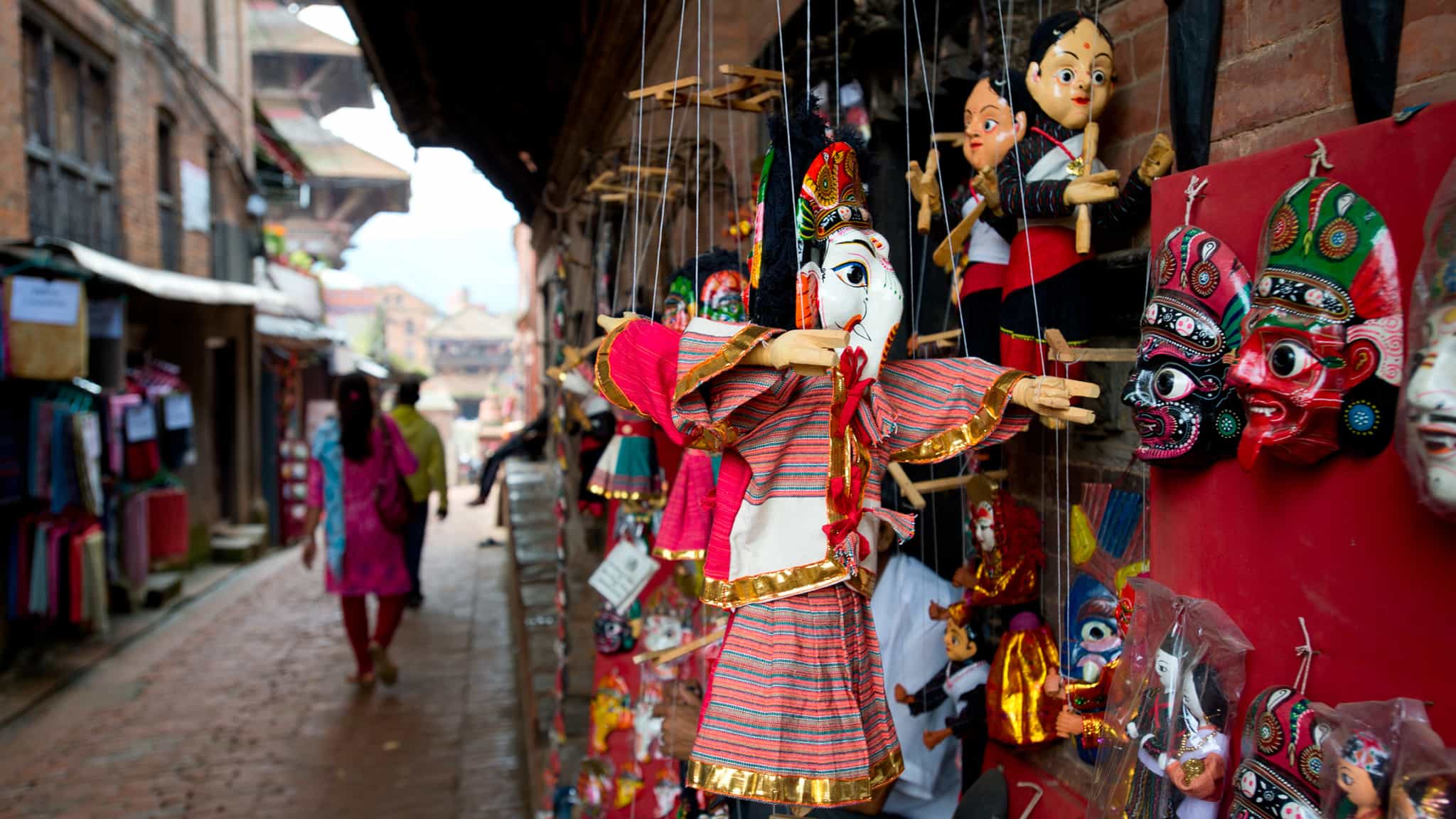
Kathmandu
On your first and last nights, you’ll stay in a centrally located tourist hotel in Kathmandu's Thamel area on a twin-share basis, with en-suite bathrooms, air-con and WiFi. The hotel is located in the heart of Thamel, close to the main shopping area and the heritage sites.
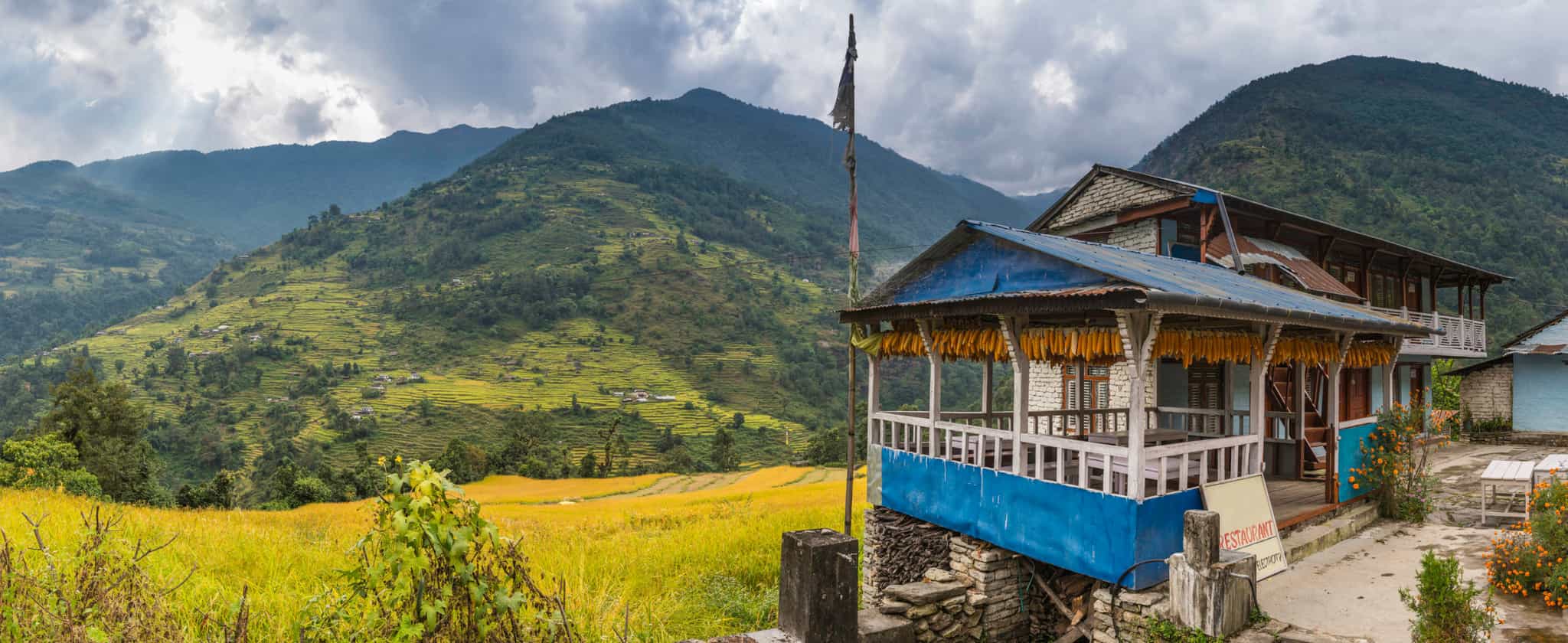
Annapurna Circuit
During the trek you'll stay in traditional teahouses – these are mountain lodges that tend to have a communal dining area and basic toilets. Rooms are usually sorted by gender and many offer hot showers or phone charging for a small fee. There’s no heating, so your warm sleeping bag is needed.

Pokhara
On your night in Pokhara you'll stay in a hotel near the lake, close enough to all the action but still in a quiet spot.
Upgrades
For solo travellers looking for their own space, an optional private room can be booked for an extra charge, see Optional Extras for the price. This is only applicable to the nights spent in hotels and is subject to availability. Please request this at the time of booking.
This trip has been rated as Challenging
Much of this trek is within the capabilities of people with good fitness who are keen trekkers. Still, it is important to note that trekking at altitudes above 3000m/10,000ft is more demanding on the body than walking at low elevations.
Some training beforehand will help and we advise doing at least one weekend of back to back days walking. The guide will set the pace and as with all altitude treks, the theme is ‘slowly slowly’ to help you adjust to the altitude.
What will I need to carry?
This trip includes one porter for every two trekkers. They will carry up to 20-25kg of kit so your overnight bags and spare clothes will be transported for you (maximum 12kg per person). You will only need to carry a daypack with essentials in (extra layer, snacks, water, suncream, camera etc).
There are 3 different seasons for trekking in Nepal:
Winter (Dec-Feb): Despite being seen as ‘off-season’ this is often the best time to trek in Nepal. The nights can be very cold (down to -20ºC) but the trails are quieter and the mountain views are often at their best due to the clear sunny skies.
Pre-Monsoon/Spring (Mar-May): Temperatures rise significantly in spring and flowers are in full bloom in the lower areas. Although it can still drop below freezing at night, the daytime temperatures tend to sit between 10-15ºC.
Post-Monsoon/Autumn (Sep-Nov): This is the most popular time to trek in Nepal with generally sunny and mild days. It can get cold and windy at higher altitudes, however the skies are usually clear.
Of course, mountain weather is notoriously hard to predict and snow can be expected on any trip so come prepared.
As the Annapurna Circuit has wide trails, and much of it sits in a rain shadow, the summer months of June-August are still good for trekking. These months are a great time to have the trails almost entirely to yourself.
Absolutely amazing experience!
The Annapurna Circuit is definitely one of the must-do treks in Nepal. I was very lucky that I had a fantastic group and team of guides to work with. Pujan, Bhawisya, Ananta, Lila and our supporting staff Mohan, Arjun, Samer, Sujan, Bhumi all worked incredibly hard to give us an amazing experience. Unfortunately, I had to come back to Kathmandu a few days early due to sickness, but everything was organised for me and I was looked after the entire way back.
The views from this trek are some of the best in the world. The accommodation and food were excellent considering how remote we were at times. If you're considering this trek, go for it! You won't regret it!
Breathtaking. . . figuratively & literally
Trekking the Annapurna Circuit was an unforgettable adventure. If you're looking for a taste of the Himalayas this is the one to book. The beauty is breathtaking—both figuratively and literally—so I highly recommend training beforehand. With 12 days of trekking at altitudes exceeding 3000-5000m+, even the fittest individuals can find it humbling, especially when faced with challenging weather conditions.
It's been just over a month since I returned from Nepal, and not a day goes by that I don’t reflect on and relive this adventure.
Our incredible journey would not have been possible without the exceptional leadership of Tika and his amazing team: Dili, Pipi, Lila, and the legendary porters. I am immensely grateful for their tireless efforts to ensure our group was well cared for.
Don't hesitate, book it!
Good taste of 5000m+
A great multi-day trekking experience. Plenty of time to acclimatise on the way, so you get plenty of time to appreciate the landscape you are in. I would recommend trying some hiking above 3000m and some multi day hiking beforehand so you know that you feel prepared for the effort involved.
Brilliant trek!
Such a great experience, I absolutely loved this trek! The guides Pujan, Bhavhishia, Ananta and Lila, were brilliant. They took great care of us and were always checking we were managing the altitude ok. I also want to call out the porters Arjun, Mohan, Samer, Sujan, Bhumi, and Dhanraj - always friendly and we're grateful for their hard work. The trek was highly organised from start to finish and I was lucky to have a wonderful group to hike with as well! And the views of course were insane - it feels like you go deep into the Himalayas, it's an incredible experience. Definitely recommend!
Annapurna Circuit May 2025
A truly unforgettable experience. This trip was incredibly well organised and I felt supported from the moment I booked the trip with the virtual support of the Freedom Adventures team. No questioned went unanswered.
Our lead guide, Kirshna, was fun, knowledgeable and ensured our safety was the priority throughout the trip. He was supported by Ashish and Resham who went above and beyond for us all. Our porters Suria, Kahem, Raju and Ananda were always ahead of us and greeted us in each day with a big smile. I couldn’t have asked for more.








The best team made for an unforgettable trek!
Our whole trip was incredible and made possible due to the amazing team at Freedom adventures. We did Annapurna Circuit in April 2025 and our lead guide Tika made sure we were all well prepared with the right gear, and along with Dili, Lila and PiPi looked after the whole group in every possible situation whether that was navigating through difficult weather, endless hot drink and food orders or helping us through health issues along the way. Tika's extensive experience was clear from the start and "trust in Tika" became the mantra of the trek. The kindness, generosity and humour of the team really helped to make the whole experience along with having safety as a constant priority. Along with the incredible guides, we also wouldn't have been able to complete the trek without the porters. They were all so friendly and their strength and endurance was something we were continually astounded by as they greeted us with fist bumps and smiles while we breathlessly stumbled into our rest stops, them having completed the same trek with ~30kg on their backs.
I would highly recommend Freedom adventures for any treks or tours in Nepal and you'll be especially lucky if you have Tika as your lead guide.



Incredible Experience
Trip was insane. Each day was different with the landscape constantly changing. Tikka and the guides were incredible and really made the trip an unforgettable experience.
Outstanding from start to finish
Trekking in the Himalayas has been on my bucket list for a long time and this trip did not disappoint!
The whole Freedom Adventures team were fantastic, from Tika our lead guide, to our support guides Lila, Dili and PP and a brilliant team of porters, they all cared for our safety and wellbeing, going above and beyond. I cannot rate Freedom Adventures highly enough.
The teahouses were all great with twin rooms (I was expecting dorms!) and if you were really lucky, occasionally an ensuite toilet! Food was also good, even when getting to higher altitudes with reduced choice.
We were lucky to have good clear weather for most of the trip (apart from the blizzard up to Tilicho Lake!) and could fully appreciate the breath-taking views in the Annapurna region.
Would love to go back and do it all again. If you are thinking about trekking in the Himalayas I absolutely recommend booking this trip.

An unforgettable Annapurna circuit adventure.
An Unforgettable Annapurna Circuit Experience with Freedom Adventures
Our Annapurna Circuit trek with Freedom Adventures was nothing short of extraordinary. From start to finish, the entire journey was flawlessly organized, and the support we received from the team made it a truly unforgettable adventure.
A huge shoutout to our incredible guides Pujan, Bhavhishia, Ananta and Lila whose knowledge, warmth, and professionalism elevated the entire experience. They were not only expert navigators of the terrain but also wonderful companions who shared stories, culture, and laughter along the way. Their attention to detail and genuine care for our well-being made us feel safe and supported throughout the trek.
Equally commendable were our porters Arjun, Mohan, Samer, Sujan, Bhumi, and Dhanraj who were absolute heroes. It was heartening to see how well they were treated and supported by Freedom Adventures, something that was very important to us when choosing a trekking company. Their strength and dedication were inspiring, and we are deeply grateful for their hard work.
Freedom Adventures truly stands out for its ethical practices, exceptional team, and deep respect for both trekkers, staff and the environment. If you're considering the Annapurna Circuit or any Himalayan adventure, we wholeheartedly recommend them. This was more than just a trek — it was a life-enriching journey made possible by an outstanding team.
And above all, it was the warmth of the Nepalese smiles that stayed with us long after the mountains faded from view.
Thanks
Kind regards
Dr Myriam Mallet (she/her)
Principal Lecturer (Learning and Teaching)
School of Computing, Engineering & Digital Technologies
T: 01642 384610
Chat with me on Teams
A white background with black text
Description automatically generated
Our Annapurna Circuit trek with Freedom Adventures was nothing short of extraordinary. From start to finish, the entire journey was flawlessly organized, and the support we received from the team made it a truly unforgettable adventure.
A huge shoutout to our incredible guides Pujan, Bhavishya, Ananta and Lila whose knowledge, warmth, and professionalism elevated the entire experience. They were not only expert navigators of the terrain but also wonderful companions who shared stories, culture, and laughter along the way. Their attention to detail and genuine care for our well-being made us feel safe and supported throughout the trek.
Equally commendable were our porters Arjun, Mohan, Samer, Sujan, Bhumi, and Dhanraj who were absolute heroes. It was heartening to see how well they were treated and supported by Freedom Adventures, something that was very important to us when choosing a trekking company. Their strength and dedication were inspiring, and we are deeply grateful for their hard work.
Freedom Adventures truly stands out for its ethical practices, exceptional team, and deep respect for both trekkers, staff and the environment. If you're considering the Annapurna Circuit or any Himalayan adventure, we wholeheartedly recommend them. This was more than just a trek — it was a life-enriching journey made possible by an outstanding team.
And above all, it was the warmth of the Nepalese smiles that stayed with us long after the mountains faded from view.



10/10 Annapurna circuit trek!
I completed the Annapurna Circuit Trek in April 2025 with the MBA team and I can't rate this highly enough - this was my first group trip and it was the most amazing experience!
The itinerary was great - we had so much trekking time each day, exploring the valleys and trails for incredible views of the Annapurna range and beyond. Our guides Pujan, Bhawisya, Ananta and Lila were fantastic - they were great at sharing knowledge and keeping morale high at tough times, with lots of jokes, songs and dances. They looked after us and kept us safe, checking we were coping with the altitude at all times and their guidelines got us all the way to Thorong La Pass, Tilicho Lake and more incredible spots. This is a great team and a special shout out to Bhawisya - it was his first experience guiding and he did a great job and can't recommend him enough for more experiences on other trips (like Everest base camp etc) - I can say I have made friends for life with the team! Our porters were also incredible - the hard work they put in to get out belongings from teahouse to teahouse, even in challenging conditions, all with a smile, was inspiring - thanks again to Mohan, Arjun, Samer, Susan and Bhumi; great boys who will look after you like family.


A huge achievement
This trek was an incredible achievement and one I won’t forget. The Annapurna circuit and trekking at altitude is hard work and so I recommend you know what you are signing up for! We had an excellent guiding team led by Krishna, with assistant guides Asis and Resam who led with professionalism and enthusiasm, always kept us safe and looked after us very well. Our 4 porters were also incredible and friendly. The teahouses were basic but clean with healthy hot meals and we always had twin rooms which were great. The transport was smooth including the light aircraft flight, and there were no issues at all. All in all, a seamless trip I will not forget! Thank you.
Annapurna May 2025
A truly extraordinary trip, great organisation and leadership by lead guide Krishna and the assistant leaders Ashish and Resham. The trip is well planned and executed with great care of all details. Accommodation and food exceeded expectations. A huge thank you to our porters Suria, Kahem, Raju and Ananda for all their help.




An amazing hiking trip
At first, I was a bit concerned because it was a long one, 16 days, with 12 consecutive days of hiking, but everything went smoothly. The scenery was outstanding, and the trail was not crowded, which was one of the main reasons I chose this route over the shorter circuit that follows a more popular path.
We were very lucky with the weather. We experienced a bit of everything, even getting caught in a snow blizzard while hiking to Tilicho Lake, but for the most part, we enjoyed clear blue skies.
The tea houses were better than expected, and the guides, Tika, Dilli, Lila, and Pashupati, along with all the porters, were phenomenal and truly looked after us. They made a huge difference and helped turn this into an unforgettable trip!
The two biggest challenges were the cold at night (though bringing a hot water bottle made a big difference!) and the food, which is quite limited due to the altitude. The main options were vegetarian rice or noodles, dal bhat, and veggie curry (the portions were huge, you definitely won’t go hungry).
If you love hiking and can endure long hours on the trail with some tough ascents, I would definitely recommend doing this trek!





Annapurna Circuit May 2025
An amazing experience in the Himalayas. Our guides Krishna, Resham and Ashish did a stellar job making sure we were safe and comfortable over the 2 weeks. Also a shout out to the porters for always being two steps ahead of us and making sure all our gear made it to the stops in the evenings. The teahouses we stayed in where all great and the food was also much better than what you would expect above 3000m. If your considering doing this trip, just go for it!

Had a great time. The
Had a great time. The tour is very well organised, guides are knowledgable (Thank you to Krishna, Asis, Resham and the postering team!!) and definitely add to the trek. The tour is very well supported, great if you don’t want to have to think about any logistics but if you’re out for a more independent experience probably not the one. I had an amazing time
Truly wonderful experience
A bucket list trek which certainly lived up to and exceeded expectations. The hiking itself was incredible and such a privilege to see those awe inspiring mountains and learn about the people and culture of Nepal.
I cannot compliment MBA and Freedom adventures enough for great communications and organisation from the airport pickup to drop-off at the end of the trip. Also, food and accommodation far surpassed my expectations.
Now to the wonderful crew who made it all happen:
Firstly our porters Suria, Kahem, Raju and Ananda who do such a tough job with smiles on their faces - they were great.
Then our assistant guides Ashish and Resam - super knowledgable guys, always there when we needed support and nothing was too much trouble, they really were excellent.
Last but not least our head guide Krishna who really was brilliant, kept us all in line with good humor, sound advice and great encouragement, thank you so much.
Finally a shout out to my fellow tourists - it’s been quite a while since I signed up for a trip like this as a solo traveller and so was a little apprehensive… all I can say is go for it, if you get to travel with a bunch half as great as I did you’ll be doing well.




It doesn’t get better than this
This was more than adventure, it was a complete experience.
Culturally Nepal offers so much whether it’s the history of a nation and birthplace of Bhudism or the friendliness of its people.
The scenery was simply breathtaking made even more memorable by the effort to reach our objectives each day.
This was no gentle hike in the hills, fitness does matter and as a septuagenarian, who has participated in extreme sports, i would recommend anyone contemplating doing the Annapurna Circuit to train for at least six months.
Altitude sickness can hit even the fittest individuals, so tip #2 is get assessed by the Altitude Centre to understand how your body reacts to altitude.
We completed the circuit including a trip to Tilicho Lake in a blizzard and accending Thorang La Pass at 5,400m a memorable experience made possible by our fantastic team of guides and porters led by the hugely impressive Tikka.
This was my first MBA trip, it won’t be my last, their organisation and communication was superb.

Brilliant trip
Amazing route and trip. Accommodation exceeded expectations and guides Krishna, Asis and Resham were the best. Always helping us if we needed anything and great company.
Also a massive shout-out to porters Suria, Ananda, Raju and Kahem for all the help too.
Unforgettable trip!
Annapurna Adventures
This is truly a bucket-list trip for anyone who is curious about what it’s really like to hike in Nepal.
The landscape changes throughout the 12 days trekking-from green forests to exposed mountain paths and frozen lakes. The views across the Manang valley were spectacular.
The planning and pace of the trek was well thought out. We built up to the longer days of Tilicho Lake and Thorang-la pass so I felt ready for these when they came. The longer days do require you to dig deep but are worth the challenge.
The trip was really made by the fantastic team from Freedom Adventures. Tika was an amazing leader, so attentive to everyone’s needs - making sure we were all eating right, looking after those who felt unwell and even locating some much needed peanut butter on request! I felt we were in such safe hands from start to finish. As well as Tika I was so grateful for care and encouragement from the rest of our guides, Dili, Lila and PP, plus the daily high 5s from our super strong support team when we finally arrived at our tea house each day.
Be prepared for cold nights, even in April/May. But I would face the cold all over again for more time looking up at these beautiful mountains.

A TREKKERS DREAM
The Annapurna Circuit was a memorable trekking journey far exceeding expectation, with stunning landscapes, varied terrains and insights into the variables of mountain life.
This trek offered more than just a physical challenge;. it provided each of us with the opportunity to discover qualities & strengths within ourselves we hadn’t previously realised we possessed, and forged new friendships.
The strength in leadership and passion for the Nepalese mountains of our lead guide, Tika was reflected in the quality and work ethic of his team, each of whom were fully engaged in the safety, comfort & well-being of the entire group throughout, providing service and support beyond that of any I have experienced anywhere else. It was with trust in Tika and his team that I was able to fully immerse in the mountain experience and focus on enjoying every moment.
A 10/10 trekking experience.
The efficient assistance and flexibility provided by the Freedom Adventures team from transfers to post-trek options resulted in well supported and incredible experiences in Nepal.
Toally recommend all that this trip had to offer.


Great, all around!
The trip was super well-organised. The hike itself is totally manageable, the days add up by the end, but one doesn't need to be an athlete to cope by any means (I had no prior high altitude experience). I was especially impressed by the local team from Freedom adventures led by Tika who went above and beyond to keep all of us safe and happy. I was quite ill for part of the trip, so absolutely couldn't have done it without them. To give an example, they refused to let me carry my backpack for days, just so that I recover fast enough to make it to the top (which I did) :) If you're thinking about hiking in Nepal, they are definitely the team to do it with.
Amazing adventure trekking the Annapurna Circuit
This has been an amazing trek in the Annapurna region. The scenery was stunning; the views of mighty peaks kept me in awe every single day; the trekking was both meditative and adventurous. Despite the unknown terrain and high altitude, I felt safe in the hands of expert lead guide Pujan and his assistant guides Ananta, Bhavisya and Lila whose combined experience, logistical precision, and knowledge of the Himalayas and Nepal, from history to traditional folk songs, combined with their positive attitude and a constant smile on their face brought the trip to the next level. All of this would not be possible without supporting staff Mohan, Bhumi, Arjun, Samer and Sujan. In terms of the food on the trek, weirdly, the higher you went the more delicious the food was, accommodation and services available in guesthouses on this trek exceeded my expectations. Top highlights were dancing at Tilicho Lake, sipping hot tea and munching on a chocolate crepe at Tharong La Pass, and celebrating our achievements in Jomsom before taking a scenic flight to Pokhara. Would definitely do it again!


In Safe hands
As a novice hiker, I appreciate the expertise of the group leaders and their support team. Our acclimatisation to the altitude was managed and monitored, which meant we all made it to the top safely and with a smile on our faces. I'd definitely recommend this trip with MBA :)
The scale and beauty of this area also blew me away. I hoped for great views, but this hike exceeded any expectations.






Annapurna Circuit: A Review of What ‘Challenging’ Really Means
Before we get into the trip itself, let’s take a moment to review the effort grading of ‘Challenging’. Now, what does that mean to a 50-something woman built for comfort, not for speed? I’d say it’s somewhere between “a character-building hike through a postcard” and “why are my thighs crying? This was an MBA trip, so let’s be honest – we weren’t expecting spa robes and welcome drinks with tiny umbrellas. But still, “challenging” is a slippery little euphemism, and I feel compelled to rebrand it on behalf of those of us who exist more for resilience than record times. I spent an hour in the gym most days for six months before the trip, and honestly, it still probably wasn’t enough. I focused on strength training, which was great for the downhill bits – less so for anything resembling a lung function test disguised as a staircase. I should’ve added more cardio training. . . or booked a holiday involving a sun lounger and a strong cocktail. But here we are. Top tip: Have some cheerleaders from home on standby. They’ll undoubtedly be reclining on their sofas, sipping chilled sauvignon blanc, but at some point – probably earlier than you'd hope – you’ll need a pep talk. For me, this moment arrived on day one. If you make it to the patchy WiFi zones further up the trail before reaching your emotional limits, congratulations, you’re doing better than I did. Day one of walking was savage. It was likely a cocktail of jet lag, travel fatigue, and pre-trip chaos, but I hit a wall. Hard. I barely knew my team, so I hadn’t yet built up enough rapport to weep openly in front of them – a missed opportunity, in hindsight. Also, the itinerary warned of a 400m vertical staircase on day two. What it failed to mention is that this was merely the warm-up act. Every day had its own personal Everest. What got me through? Sheer stubbornness and teamwork. Somewhere on the way to Manang, there’s a section that’s described as “a bit steep. ” As the slowest in the group, I was sent ahead with our assistant guide, Dilly. Whether this was a tactical move to set the pace or simply an act of kindness to spare me the shame of being lapped while audibly questioning my life choices, I’ll never know. But it worked. And speaking of Nepali understatement: “Easy for you” is anything but, “optional walks” are mandatory, and “bring your waterproofs” means that a snowstorm is very much in your near future. You get the picture. The trip to Tilicho Lake is an absolute bonus in this itinerary. It’s on a lesser-travelled section of the circuit – possibly because of the additional effort required, or maybe because it involves traversing a perilous landslide zone immediately followed by a rockfall zone. And that’s all before you reach the lake, which you may or may not see depending on the weather. We were greeted by a glorious -15°C blizzard and a flat, white expanse that was apparently Tilicho Lake. But after nine hours of battling the elements to get our photo with the sign (because otherwise it doesn’t count), we then had another 3. 5-hour walk uphill to our next lodgings. My repeated, impassioned pleas to be carried by horse were refused. Still – 10/10, totally worth it. The lake, the 350m swing bridge, and obviously the mighty Thorong La pass were all strong candidates for a full emotional breakdown, equipment failure, or a moment of existential doubt. And all of us had at least one (except Leanne, you absolute legend). But those shouldn't overshadow the real milestones: foraging for crunchy peanut butter, managing leaking hot water bottles, losing wallets/keys/dignity, and – perhaps most memorably – taking out the entire Upper Pisang power supply with a single hairdryer (yes, Ana, this is now officially in the annals of Annapurna legend). The team handled everything with grace and good humour. The Freedom Adventures crew weren’t just professional – they were exceptional. Kind, respectful, and endlessly patient, they cared for us with the protectiveness of a slightly overbearing parent. They were guides, therapists, and friends all wrapped into one, smiling their way up the trail like it was a nice stroll out in the fresh air. Tika is a phenomenal leader, and every member of his team reflects that strength. I couldn’t have done this without them, and I’m truly grateful. Would I do it again? Eventually. Maybe. Definitely. . . as long as someone else carries my bag and lies about the elevation gains.
Annapurna Circuit and Tilicho Lake
Just returned from 12th April Annapurna Circuit trip. What an incredible experience it was. The trek was very well planned to ensure the group acclimatised well to give us the best chance of succeeding in the high altitude sections. The scenery was stunningly beautiful, particularly the lake section. Our group was ably led by Pujan, with assistant guides Ananta, Bhavisya and Lila. They were a great team, always ready to share their knowledge and passion, and made us feel confident in our adventure. The six supporting staff (including a special mention for Mohan who stepped up to be an assistant guide) were also great, and we enjoyed having dinner with them on our last night. The tea houses were much more comfortable than I’d expected. Food was great in the majority, and all the rooms were twin with the odd triple bed. Some highlights were the sheer scale of the mountains, the 2 days where we started hiking in time to watch the sun rise, Tilicho lake, numerous eagles, and the fabulous group of people who I shared all this with.
Would highly recommend this trip to anyone who loves walking and mountains!
I thoroughly enjoyed my trip,
I thoroughly enjoyed my trip, which was well organised throughout and allowed me to relax and enjoy the hiking and views.

Annapurna April 2025
This journey was truly extraordinary! As a solo traveler, I was curious about group travel for such a challenge. It exceeded all expectations and I met inspiring, like-minded adventurers. The flawless organisation allowed us to fully immerse in the breathtaking landscapes and the climb without worry. Our lead guide Pujan, our assistant guides Babisha, Ananta, Lila, and porters/supporting staff Mohan, Arjun, Samer, Sujan, Bhumi ensured a seamless experience. They provided expert knowledge on the best routes, accomodations, local culture and health precautions, including altitude safety checks. Along the way, they helped us to gain deep insight into Nepal's traditions, folk songs and dances, history, geography, religions and diverse communities. The energy of this team was unmatched. I could see that MBA supports aspiring guides in achieving their dreams. All our crew was extremely qualified and also properly equipped for the trek.
We trekked at the perfect pace, celebrating every milestone. Every moment was unforgettable - from the lush Besisahar to the snowcapped Annapurnas, the rugged Mustang valley and stunning Himalayan views from. Our flight. Sunrise on Tilicho lake and Thorong la Pass were true highlights. Special shoutout to Manang valleys peaceful temples, delicious apple pies and adorable baby yaks.
Already dreaming of returning. I'll definitely choose this company (and guides) again. Jam Jam !
Absolutely worth it
Incredible views, great company and an absolutely fabulous team. Pujan and his assistant leaders Bhawisya, Ananta and Lila went out of their way to make this an unforgettable experience. Huge thanks also to our porters Mohan, Arjun, Samer, Sujan and Bhumi.




Amazing trek!
The trip was fantastic. It exceeded my expectations. The views, the company and the beautiful country of Nepal. I loved it, especially the hike to tilicho lake. The leader and his team went above and beyond to make our trip run smoothly. They were so helpful. I can’t recommend this trip enough. Thank you to Pujan, Bhavishya and all the team for such a great 2 weeks!










Annapurn Circuit - Incredible
Our trek with Freedom Adventures through Much Better Adventures was incredible, and I would do it again in an instant. The views are stunning, the walking enjoyable and the company good.
We could not have asked for a better team than that lead by Tika and his assistant guides Anil, Pravin and Santosh. Tika's guiding experience is evident; he is a strong leader with deep knowledge of the route. He kept a watchful eye on all of us to ensure that we could complete the trek. The assistant guides were nothing short of fantastic; always available to lend a helping hand, share knowledge, and teach the occasional Nepali card game. By the middle of the trek the guides felt more like family than guides. If I had to summarize the guides on our trip in a few words it would be these: Prepared, knowledgeable, lighthearted and easygoing.
Overall I give the trek and guides 10/10, would recommend.
Itinerary Activities
- 11 days of guided hiking on the Annapurna Circuit, from Tal to Kagbeni
- Visit to a remote Tibetan monastery
- Optional visit to Gangapurna Lake or Himalayan Rescue Association
- Guided hike to Tilicho Base Camp (dependent on weather conditions)
Guides
- Local, expert, English-speaking guides
Accommodation
- 4 nights in hotels or guesthouses
- 12 nights in traditional Nepalese teahouses
Meals
- 3 tasty breakfasts
- A welcome dinner in Kathmandu on Day 1
- A celebratory dinner in Pokhara on Day 15
Internal flights
- Flights between Jomson and Pokhara
Transfers
- Arrival transfers from Kathmandu Airport before 16:00 on Day 1
- Departure transfer to Kathmandu Airport at any time on Day 17
- All transfers during the trip
Porterage
- Porters will carry your overnight luggage on the trail
Permits
- All your trekking permits and fees are covered and sorted
Our trips are hassle-free by design. We include all the activities and equipment, so you can simply rock up with your rucksack and share the adventure with your new pals.
Travel to and from the trip
Our trips do not include flights, trains or other travel to the start point and back from the end point.
Meals
We do not include meals on the trekking part of this trip, as from experience we know that altitude and physical exercise can mean appetites vary hugely.
The cost of food rises as you ascend as it is all carried in by porters and yaks and as you get higher up, very little food can be grown. How much you spend per day will vary according to your choice of meal but generally, people spend between $25-$35 per person, per day on meals and hot drinks. Below is an approximate breakdown of some items:
- Dal baht: $4 to $7
- Chow mein: $2 to $4
- Eggs: $2 to $4
- Toast: $1.50 to $3
- Tea/hot chocolate: $1 to $3
- Chocolate bars: $2 to $4
Teahouses will provide cold water free of charge; however, it needs to be treated to enable you to drink it. Please read the FAQ below regarding our advice here.
Miscellaneous costs
Other extra costs at the teahouses to be considered are:
- Shower: $2-$4
- WiFi: $2-5
- Electricity: $2-5
Tips
It is customary in Nepal to tip guides and porters. Although it may not be customary to you, it is of considerable significance to the people who will take care of you during your travels. You can give any tips to your lead guide at the end of your trip. This will then be shared amongst the whole team. For full transparency, the lead guide will distribute the tips to the guides and porters in your presence. It is customary for the guides to receive a higher share than the porters as they are more highly qualified.
A good rule of thumb is around $165pp as a tip, although the amount you give is entirely your choice.
If you would like to give an additional tip to a member of the team who has supported you personally, please do so directly and discretely.
Travel insurance
Travel insurance is compulsory for all of our adventures and you are required to provide your policy information before departing. Your insurance should include adequate protection for overseas medical treatment, evacuation/repatriation, your baggage and equipment and the specific activities involved on your adventure. We also strongly recommend it includes cancellation and curtailment insurance, should you be unable to join your trip for specific reasons such as illness. Our recommended travel insurance provider is Campbell Irvine, as their insurance offers all of the above.
Owing to the nature of this trip, it is essential that your personal travel insurance policy provides cover to the maximum altitude visited on this trip (5416m) as well as for emergency medical evacuation by helicopter.
Visas
Visa requirements often change, and you are responsible for obtaining any required visas for this trip. Please check with your nearest embassy or consulate for up-to-date advice.
Personal Expenses
You know your own spending habits best, so please budget an appropriate amount for things like optional meals and drinks, shopping, optional activities, and laundry.
What do I need to bring?
- Day pack with rain cover (30 litre +)
- Duffle bag (for the porters to carry your overnight kit)
Clothes
- Waterproof jacket with hood
- Mid-weight down jacket
- Waterproof trousers
- Lightweight trekking trousers
- Hiking shorts (if trekking in the summer)
- Thermals (top and bottom, merino ideal)
- 2-3 trekking t-shirts/shirts
- Fleece or warm mid-layer
- Waterproof thick gloves
- Glove liners
- Hiking socks and lighter walking socks
- Wool hat
- Sun hat
- Spare underwear
- Buff or similar
Shoes
- Worn in waterproof hiking boots
- Lightweight trainers (for the evenings)
- Flip-flops or sandals
Sleeping
- 4-season sleeping bag
- Sleeping bag liner
- Pillow case (optional)
Other
- Trekking poles
- Travel towel
- Sun protection (sunscreen, sunglasses)
- 2 water bottles (1 litre each)
- Metal SIGG bottle (useful to fill with hot water to use as a hot water bottle at bedtime)
- Headtorch
- First aid kit and/or personal medication
- Water purification tablets/system
- Hand gel
- Biodegradable wet wipes
- Small biodegradable bags to take toilet tissue off the mountain
- Toilet paper/tissues
- 1 x passport photo for trek permit
- Powerbank
- Universal plug adaptor
- Book/kindle/cards for downtime
Winter departures only (end Nov until Mar)
- Gaiters
- Microspikes
- Extra warm layers (add an extra warm item to all key items above)
- Extra set of thermals (pair to walk in, pair to sleep in)
- Merino trekking socks
- Merino glove liners
This winter kit can sometimes be necessary even in the high season, depending on weather conditions. Your local host will contact you a week prior departure to let you know if any extra items are necessary. If you are unable to get them on time, you can also buy these items locally (see below).
What's available to hire?
The below can be rented in Kathmandu:
- Down jacket: costs approx. $1.5/day with a deposit of $50
- Sleeping bag (3-season only available): costs approx. $2/day with a deposit of $80
- Spikes (for winter departures only) costs approx. $1.5/day.
(Please ask your host if this is needed so they can assist you with how to arrange the hire.)
What can you buy in Kathmandu?
Kathmandu has many outdoor gear shops - some sell real kit that is the same price you will find it at home, and some are filled with cheaper imitation gear that may not be of the same quality. You will, however, find a soft duffel bag easily that the porters can carry.
Please remove all unnecessary packing before you leave home and ensure you take all plastic off the mountain to be disposed of in Kathmandu.
Optional Private Room Upgrade (3 nights: Kathmandu & Pokhara)
Payable Before Departure
Optional Private Room Upgrade (3 nights: Kathmandu & Pokhara)
… Per person
Extra night in Pokhara (Single Room)
Payable Before Departure
Extra night in Pokhara (Single Room)
…
Extra night in Pokhara (Twin/Double Room)
Payable Before Departure
Extra night in Pokhara (Twin/Double Room)
…
Pre/post-trip accommodation in Kathmandu (Single)
Payable Before Departure
Pre/post-trip accommodation in Kathmandu (Single)
…
Pre/post-trip accommodation in Kathmandu (Twin/Double)
Payable Before Departure
Pre/post-trip accommodation in Kathmandu (Twin/Double)
…
We partner with the World Land Trust to ensure this trip achieves Net-Zero emissions. We also support their Buy an Acre programme, helping local communities to buy and protect natural habitats in perpetuity.
What's the number?
It works out on average at 570kg of CO2 emissions per person, including all local transport, accommodation, food, activities, guides, staff and office operations.
The only thing it doesn’t include right now is flights and travel to the destination. We do make an overall estimate across all our customers separately, but as we don’t book flights, have customers from all corners of the world, and no way of reliably knowing their travel plans, we simply can’t include an individual number in the figure on display here. We’ve got a goal to fix that, so that when you book, there is a way to measure and mitigate the carbon emitted by your flight too.
But what does the number mean?
Yep, hard to picture eh? To give you an idea:
- Driving 1000 miles/1609km would be approximately 281kg of CO2 in an average car (or 140.5kg per person, if there were two of you in it).
- A return economy class flight between London and New York would be approximately 1619kg (1.66 tonnes) per person.
- 10 trees in a temperate forest are estimated to remove approximately 250kg of CO2 from the air in a period of 5-10 years.
What are we doing about it?
Our trips are relatively low-carbon by design, and we're working with all our hosts to develop long term carbon reduction plans. We partner with the World Land Trust to ensure this trip achieves Net-Zero emissions. We also support their Buy an Acre programme, helping local communities to buy and protect natural habitats in perpetuity, ensuring the protection of the reserve and its wildlife.
Want to know more?
Amazingly, no international travel company has ever publicly published their carbon measurements before, as far as we know. We believe that must change, quickly. So we’re openly sharing the method we used in the hope that other companies will be able to more easily follow suit and build on what we've done so far. You'll find it all here.
The preferred currency is the Nepalese Rupee (NPR). Whilst ATMs are available in the main cities, please do not rely on them as they are often out of order and most have a maximum withdrawal limit equivalent to about £300.
It's best to bring the bulk of your money with you in cash, then exchange it at a bank or at one of the many money changers in Nepal – your guide can help you with this. Most major currencies are accepted, including GBP (Sterling), Euros and US Dollars, however Scottish or Northern Irish currency cannot be changed. Keep your exchange receipts in case you want to change any unused Rupees back into hard currency when you leave Nepal (it is illegal to export Nepalese Rupees, as it is a closed currency).
You will need to carry a fairly large amount of cash while trekking, for the meals (see 'Not Included' above). We advise that you keep this in a waterproof bag and in your day bag along with your passport.
We work with some of the best leaders in the industry. Every single one of them is government licensed and very experienced. In order to ensure guides’ high standard of performance, the host provides them with top-notch in-house training that covers Leave No Trace (LNT) principles, advanced wilderness first aid, hyperbaric chambers, oxygen systems, mountain rescue and incident management.
Although we schedule departure dates outside of the main monsoon season, weather conditions in any mountain region can be unpredictable and sometimes your host will need to revert to 'Plan B'. No two trekking seasons are the same but occasional landslides after Yak Kharka or heavy snowfall at Thorong Phedi or on the Thorong La are known to lead to trail closures on this route.
If the trail is closed or deemed unsafe, your host will organise an alternative trek – usually an extended version of the Annapurna Sanctuary Trek (also visiting Australian Camp). However, if after you’ve set off on the Annapurna Circuit Trek an issue subsequently arises and you cannot cross the Thorong La, you’ll have to retrace your steps back to Taal.
At the end of the trek, a flight from Jomsom to Pokhara is included – if this is cancelled you will drive to Pokhara instead.
You can leave any luggage not needed during the trek at your hotel in Kathmandu.
This trip includes one porter for every two trekkers. They will carry up to 20-25kg of kit so your overnight bags and spare clothes will be transported for you (maximum 12kg per person). You will only need to carry a daypack with essentials in (extra layer, snacks, water, suncream, camera etc).
We’ve sourced some great optional activities for you to do in and around Kathmandu should you wish to explore that little bit further. Please discuss these directly with your host who will be able to book them for you.
Cook Like a Local: This short cooking workshop (approx. 3 hours) teaches you how to cook popular Nepali dishes like momos and dal bhat. You’ll meet your teacher and accompany them shopping, then head to the kitchen and learn to cook alongside them. Price: Pay what you think the workshop is worth!
Shop Local: A 2-3 hour guided exploration of the markets of Kathmandu. Prepare to learn about the vendors that line the crowded narrow alleyways and witness everything you could ever imagine being sold, haggled and bargained for. A great experience to learn about the melting pot of cultures that exist in Kathmandu. Price: $9-$50pp, depending on the group size
Master of the Arts: Patan Durbar Square is popular for its Fine Arts and this trip will explore the local factories where handicrafts are made. You'll visit 2-3 factories to learn about traditional processes and see art being produced. Price: $14-$59pp, depending on the group size.
Introduction to Shamanism: Shamanism, which is believed to heal many diseases, is not practiced widely these days however this trip enables you to meet a practising Guru and learn all about this age-old tradition. You'll visit a small house to have an introduction, followed by lunch and a drumming session where you'll learn the importance of rhythm pattern to healing. Price: $90-$150, depending on group size.
Lakeside Pokhara, with its laidback vibe, is a popular spot to relax after a trek. Although the tour starts and ends in Kathmandu, your host can arrange extra nights for you in Pokhara after your trek. They will simply shift your included bus transfer from Pokhara to Kathmandu and your final night's hotel reservation in Kathmandu to a later date for you, so you'll only need to pay for the additional accommodation in Pokhara.
Although most teahouses have the option to buy bottled water, we advise against it to reduce the use of plastic in the mountains (this ends up being burnt or dumped into landfill out of sight).
You will instead be provided with cold water that needs treating. There is a wide range of products available these days which are more effective than traditional purification tablets – some trekkers like to use handheld UV devices such as a Steripen but other options are available (just check their performance in freezing conditions).
We automatically convert prices from the local currency that a host receives to your chosen currency. We update our exchange rates on a daily basis so this does mean that prices displayed on the site are subject to currency fluctuations, which is why you may see them change over time.
If you wish to change the currency you pay in, head to the bottom of the page.
This trip includes a domestic flight from Jomsom to Pokhara. Nepal's mountainous terrain and weather make for challenging flying conditions and sadly more incidents (including fatalities) occur here than in other countries. Since 2013 the EU has banned all Nepalese domestic airlines from flying within EU airspace in order to raise awareness of the poor safety record (although no Nepalese airlines were operating routes within the EU prior to the ban). You should be aware that flying in Nepal is an identified risk: please consider this carefully before booking. Additional information can be found on the Aviation Safety Network entry for Nepal as well as the UK Foreign, Commonwealth and Development Office travel advice for Nepal.
Domestic airlines in Nepal are generally not accredited by any internationally recognised safety audit systems and the Civil Aviation Authority of Nepal does not operate to the same standards as those of Western nations.
What does Much Better Adventures do about this?
Much Better Adventures collaborates with other UK travel companies to arrange for independent air-safety auditors to visit Nepal annually to assess the local airlines. Much Better Adventures then only uses the carriers that were approved as part of the most recent audit. If any concerns are subsequently raised about an approved airline between audits, we put them on hold until the auditors are satisfied that safety standards are being met.
Owing to the nature of this trip, it is essential that your personal travel insurance policy provides cover to the maximum altitude visited on this trip (5416m) as well as for emergency medical evacuation by helicopter.
This trip reaches elevations above 4500m, where the risks associated with Altitude Sickness (AMS) are higher, and where more serious conditions like HAPE (High Altitude Pulmonary Edema) and HACE (High Altitude Cerebral Edema) can occur.
Previous high-altitude experience doesn’t guarantee the same reaction every time, but it can be a helpful indicator. It gives you insight into how your body might respond, helps you recognise symptoms early, and prepares you mentally and physically for the demands of high-altitude trekking.
Your guide is trained to manage altitude risk by carefully managing the rate of ascent, monitoring group wellbeing, and taking action if anyone becomes unwell.
Before travelling, think about your own physical condition and consult a medical professional if you have concerns – especially if you have underlying health issues. If possible, arriving a day or two early at altitude is a great way to help your body adjust.
Your travel insurance must cover the maximum altitude reached on this trip and include emergency evacuation.
Sure can! Over 70% of our travellers travel solo, it’s a great way to meet like-minded people.
Our team of Adventure Hunters co-create exclusive adventures which are run by highly vetted, specialist hosts. The trip is run by our trusted host partner in the destination. We only work with independent, local, in-destination experts who know the very best places to explore and how to stay safe. Read more information about the local teams we partner with. You’ll be introduced to the host straight after making a booking via the Much Better Adventures platform.
Much Better Adventures refer to the UK Government’s official travel advice when designing trips and monitoring trip operations. We recommend that all customers are familiar with the practical information provided on the Government’s FCDO website, where current travel advice can be found by searching for the applicable destination(s).
For customers joining this trip from other international destinations – please also read the official travel advice applicable to your country of residence/origin, as this may differ.
We recommend checking out the country-specific information and also talking to a travel nurse.
We automatically convert prices from the local currency that a host receives to your chosen currency. We update our exchange rates on a daily basis so this does mean that prices displayed on the site are subject to currency fluctuations, which is why you may see them change over time.
If you wish to change the currency you pay in, head to the bottom of the page.
All of our group adventures are specially designed for adults to enjoy as we want these adventures to bring together outdoorsy people who are truly like-minded. You must be over 18 to join one of our trips.
You're always in good company on one of our adventures.
Our trips are typically made up of a mixture of solo travellers and small groups of 2 or 3 friends, with most in their 30s-50s.
Our sociable adventures are solo-friendly by design and naturally attract outdoorsy people with a shared mindset; a love for adventure, a desire to push themselves and meet awesome, like-minded people along the way.
It’s this camaraderie that has so often turned a great adventure into a life-changing one.
Don't just take our word for it:
- 95% of people rate the group dynamics on our trips 5/5
- 90% of people recommend joining a trip to make new friends
- 75% of people have met people on our trips that they would now consider friends
See here for more info about the Much Better Adventures tribe.
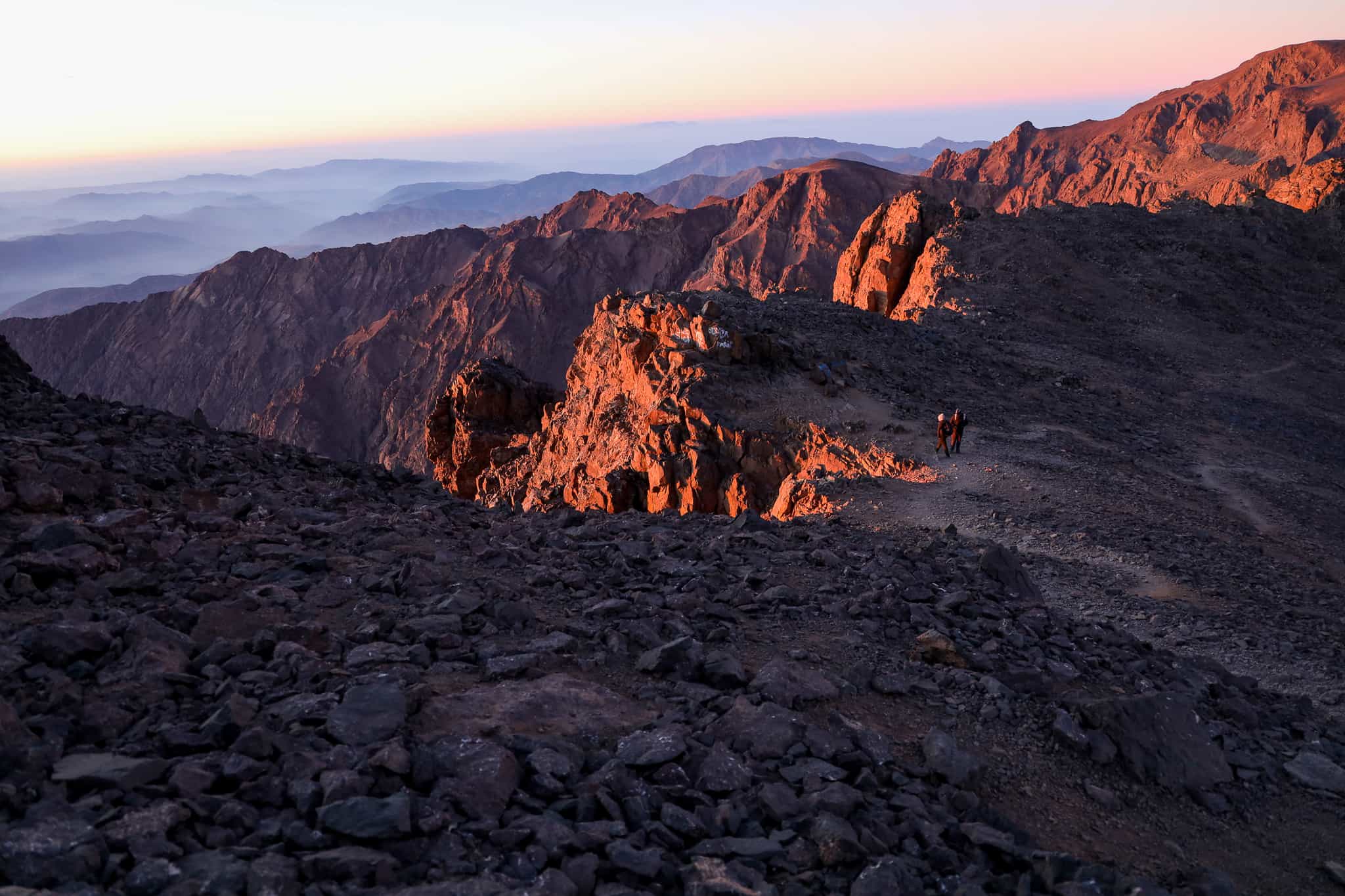
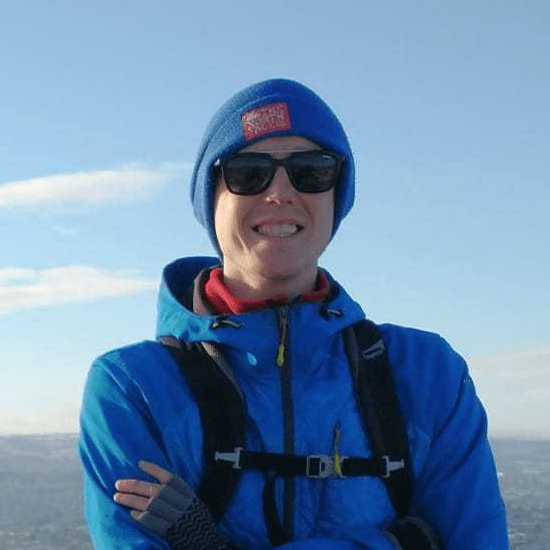
Need help finding flights?
From logistics and how to get there, to fitness, group dynamic and trip difficulty, Rory and his team of friendly experts are on hand to help.
We've got your back
Guaranteed to run
All Much Better Adventures trips are now guaranteed to run. Once you’ve booked your spot you can immediately make your travel arrangements, no uncertainty, no hanging about (excludes 'request to book' departures). Full details
Flexible payments
Secure your spot with the minimum deposit and pay off the remaining balance in as many instalments as you like, with no interest or fees. Full details
Happiness Guarantee
We’re so confident you’ll have an amazing time we’ll put our money on it. Full details
Full financial protection
To give you complete peace of mind Much Better Adventures is backed by ABTOT, ABTA and ATOL memberships. Full details
Tried & Trusted
Much Better Adventures is rated ‘Excellent’ on Trustpilot with over 1000 verified trip reviews averaging 4.8/5.
Connect before you go
You'll be invited to join a WhatsApp group to get to know each other before your big adventure together. Full details
DEPARTURE DATES
Saturday 13th September 2025
to Monday 29th September 2025
Saturday 20th September 2025
to Monday 6th October 2025
Last Minute Offer - Next 3 spots available at 10% off
Saturday 27th September 2025
to Monday 13th October 2025
Last Minute - Next 1 spot available at 10% off
